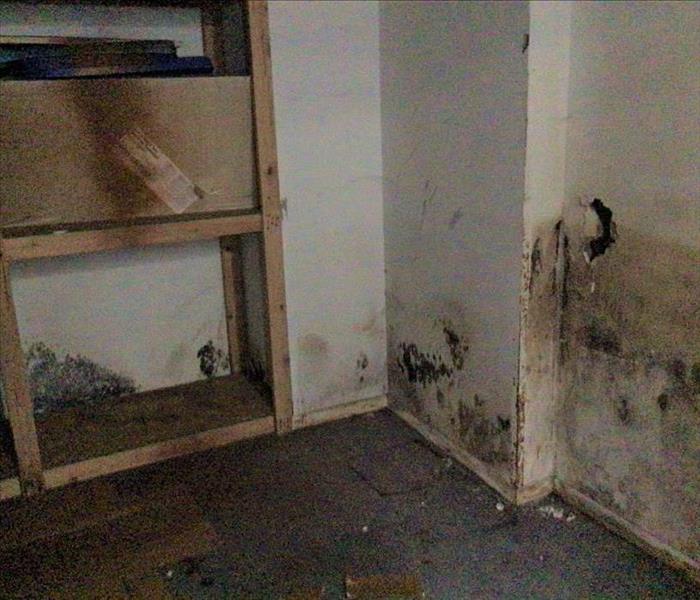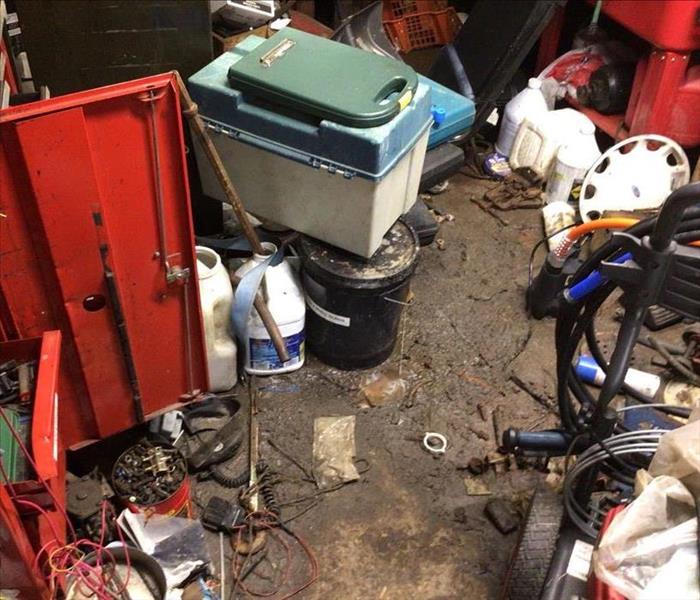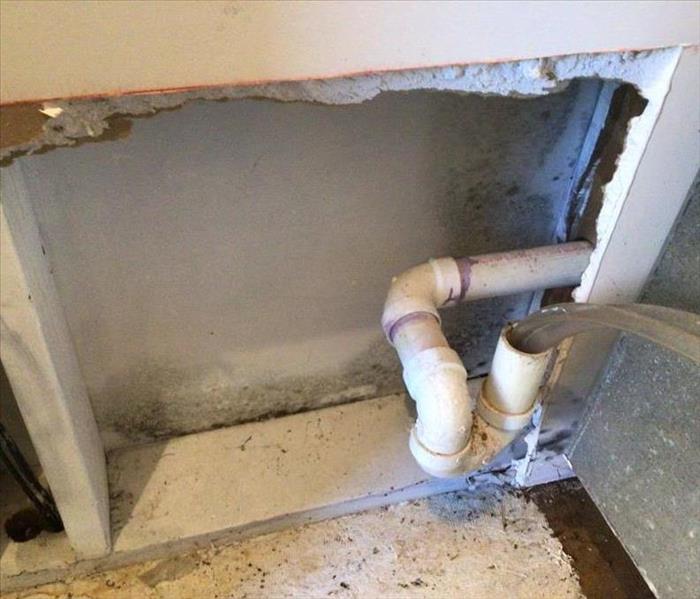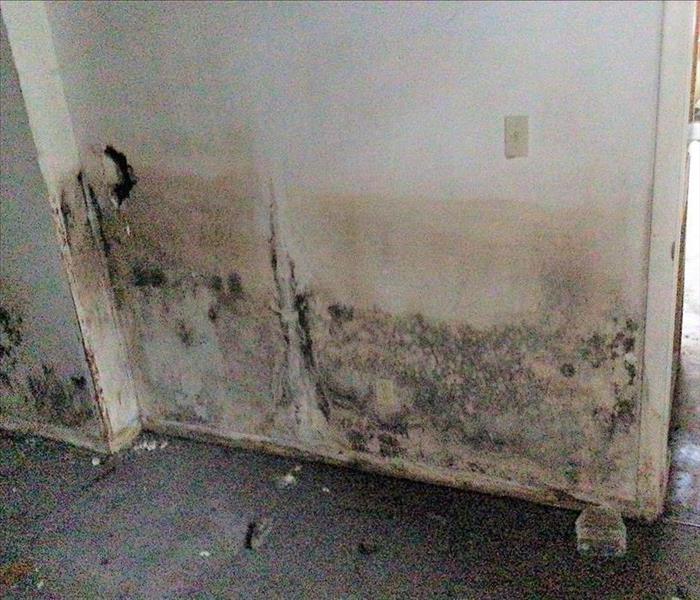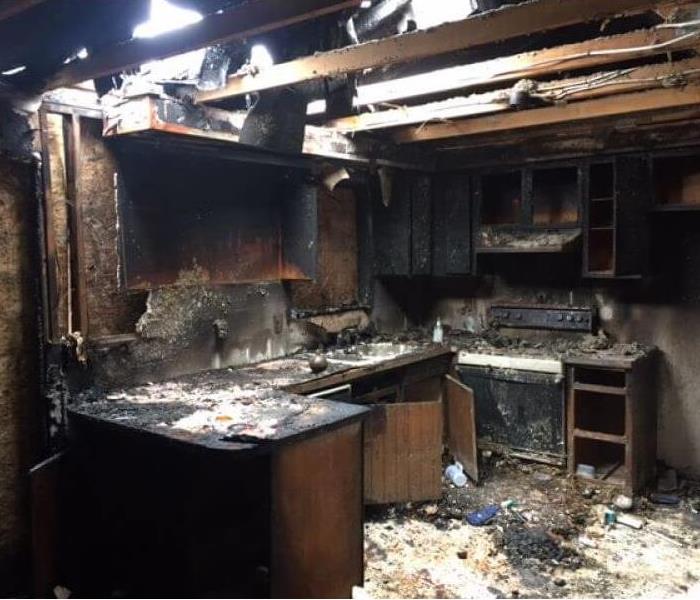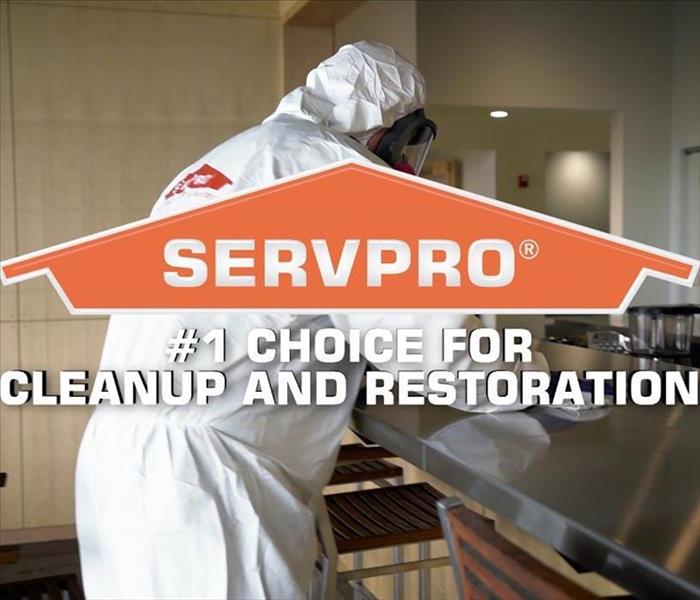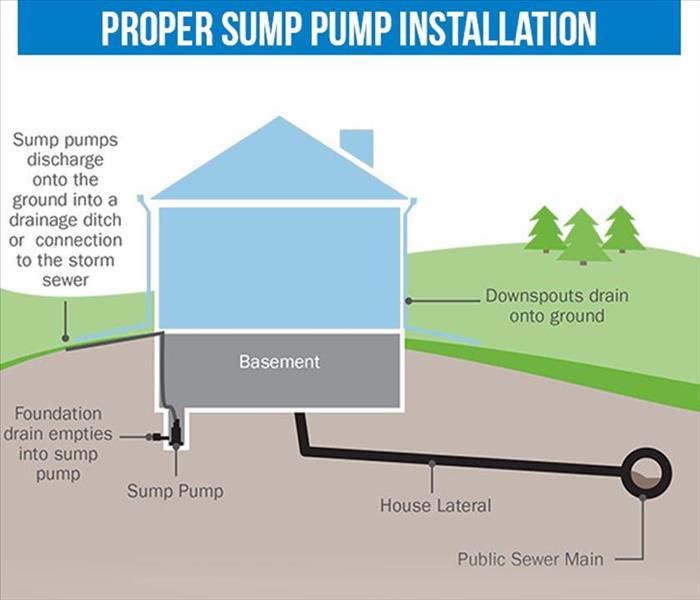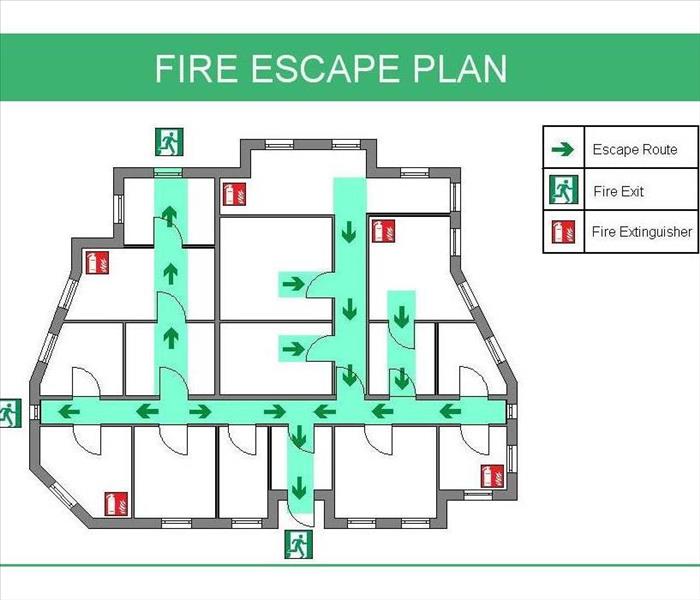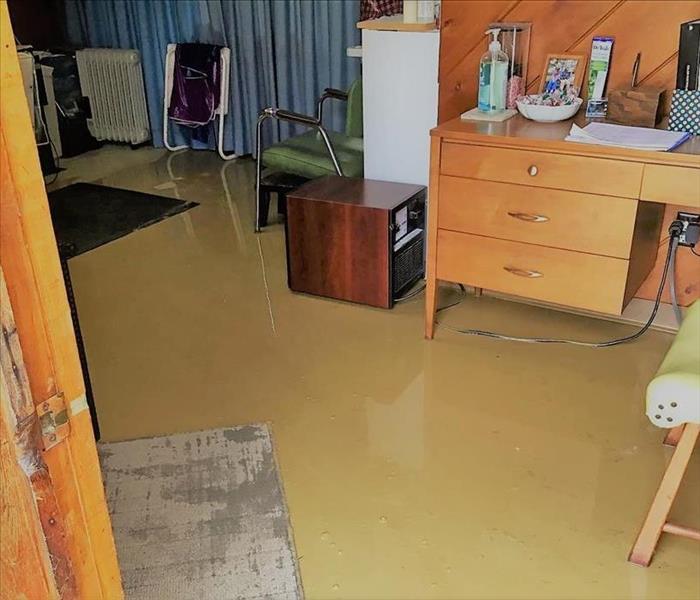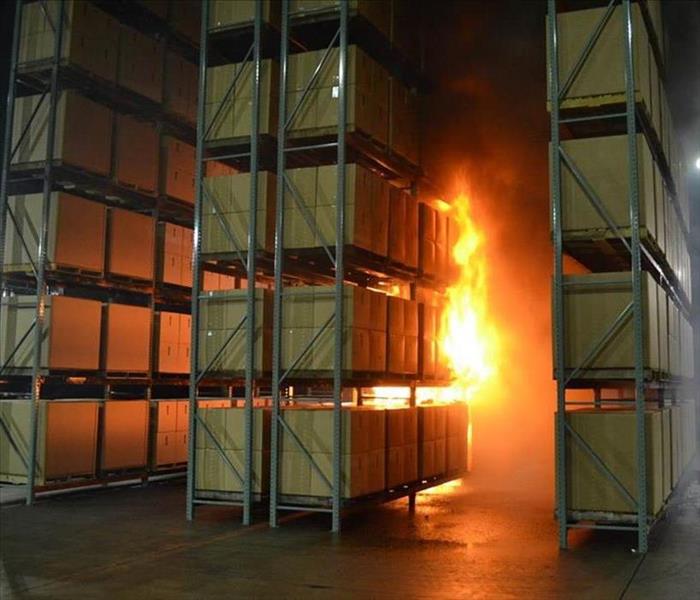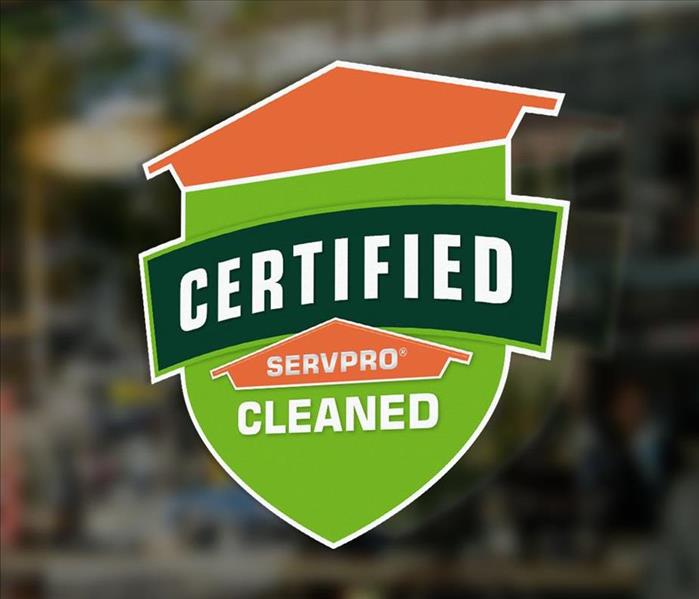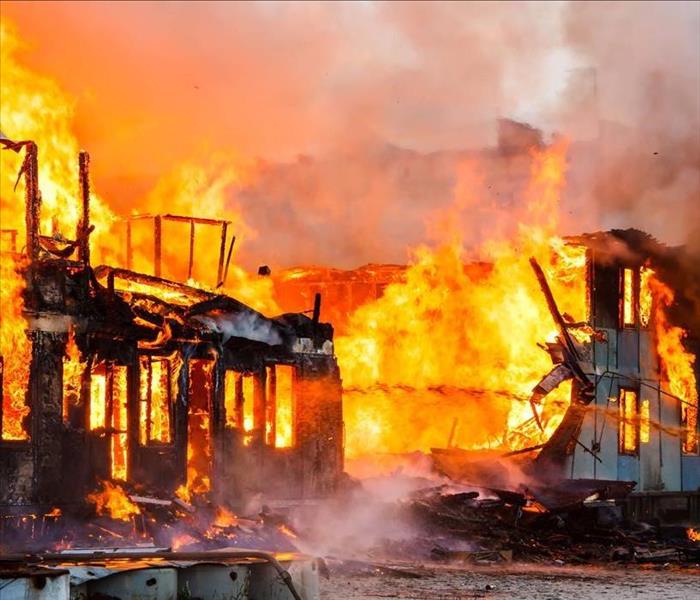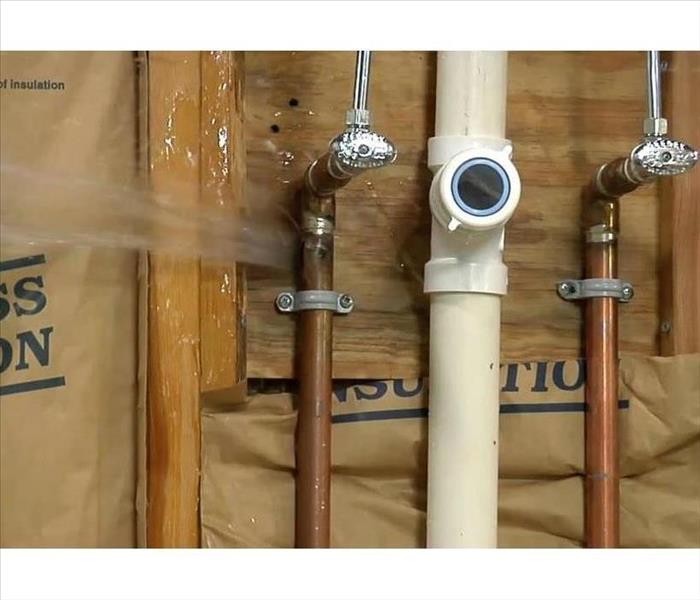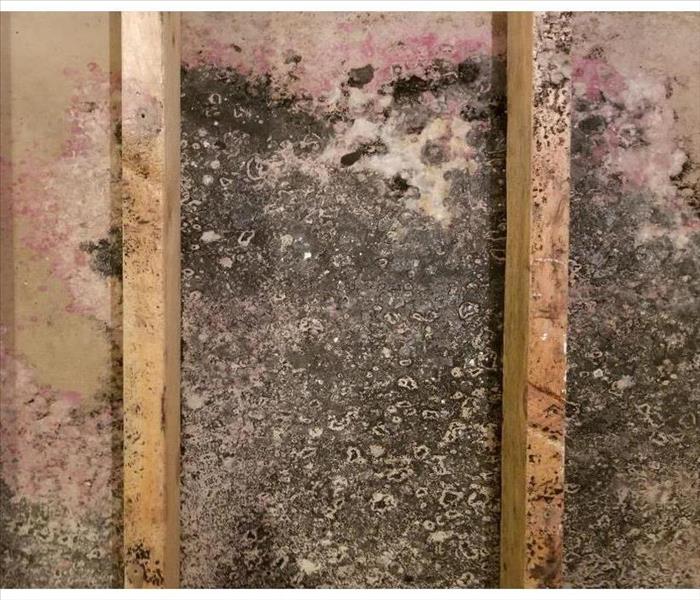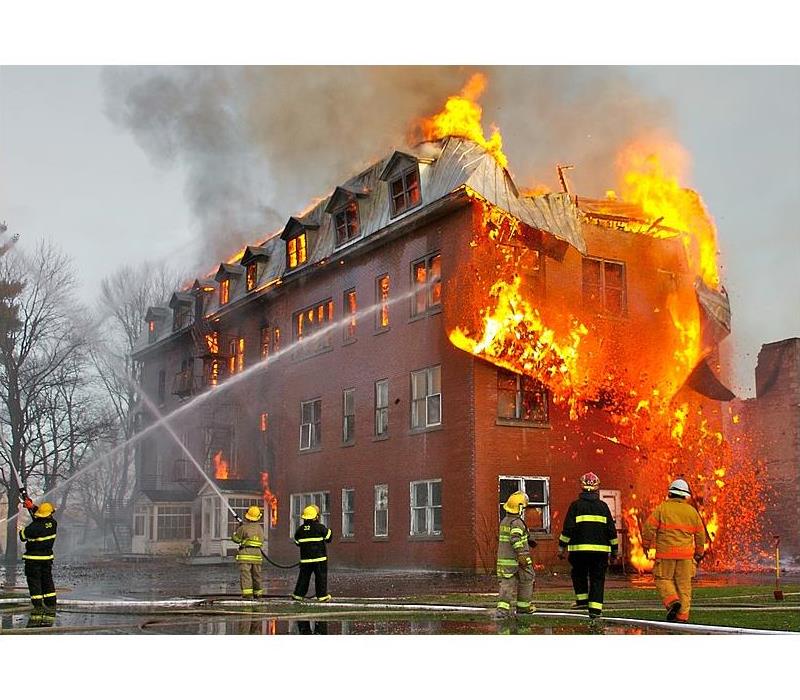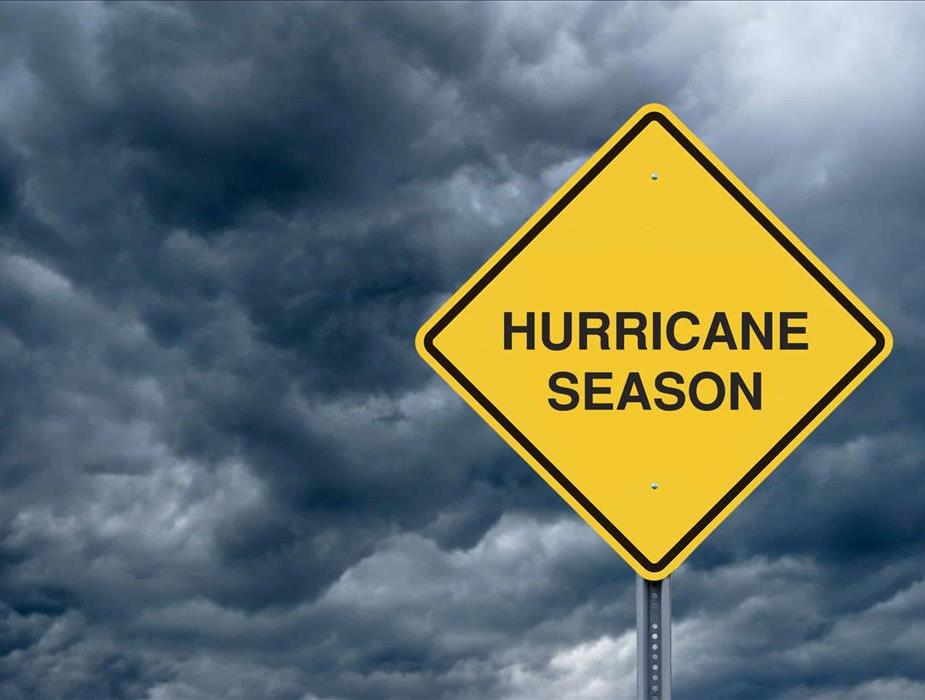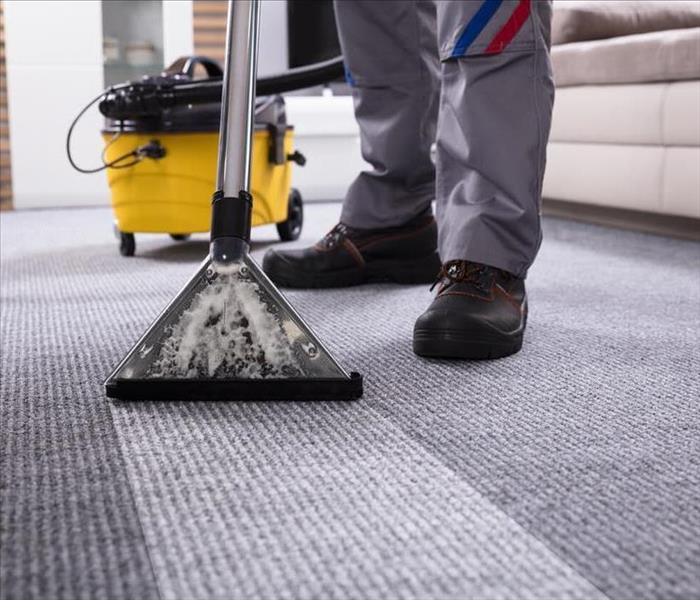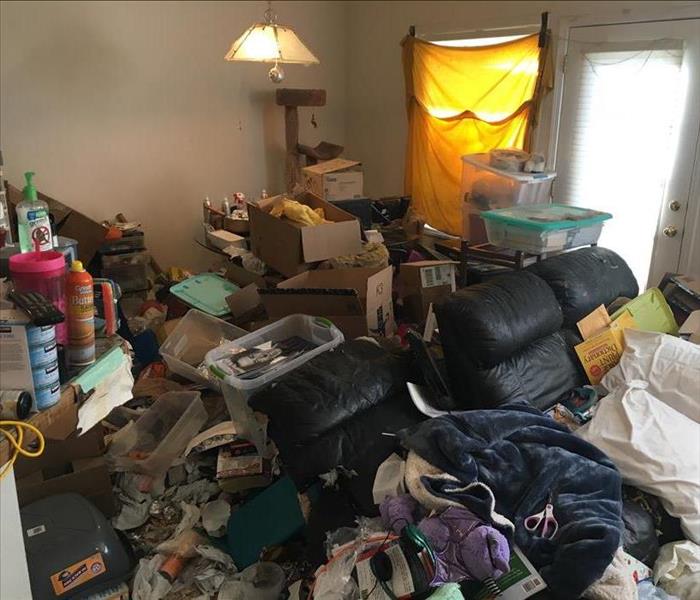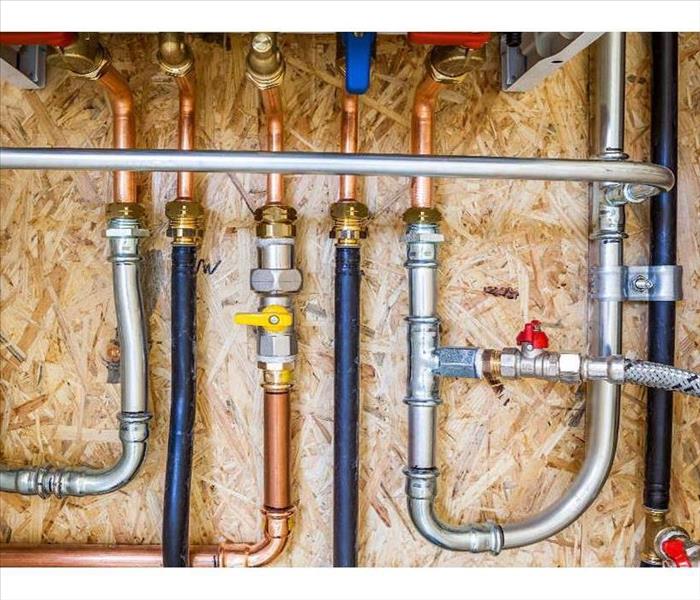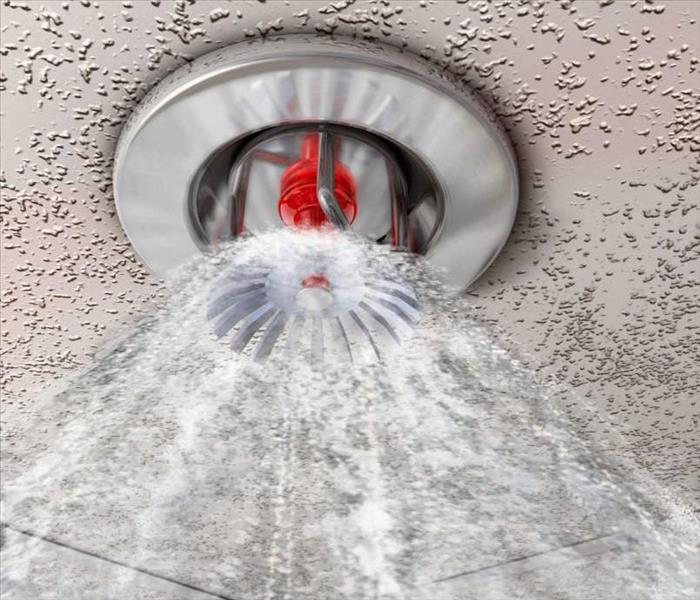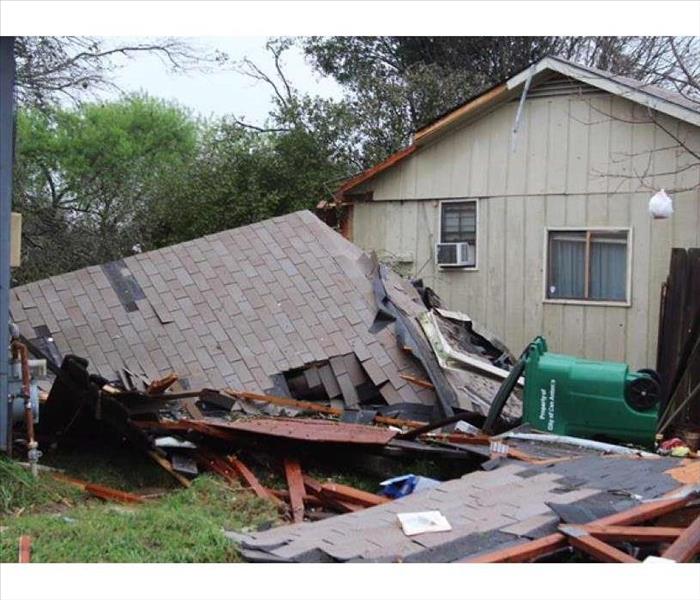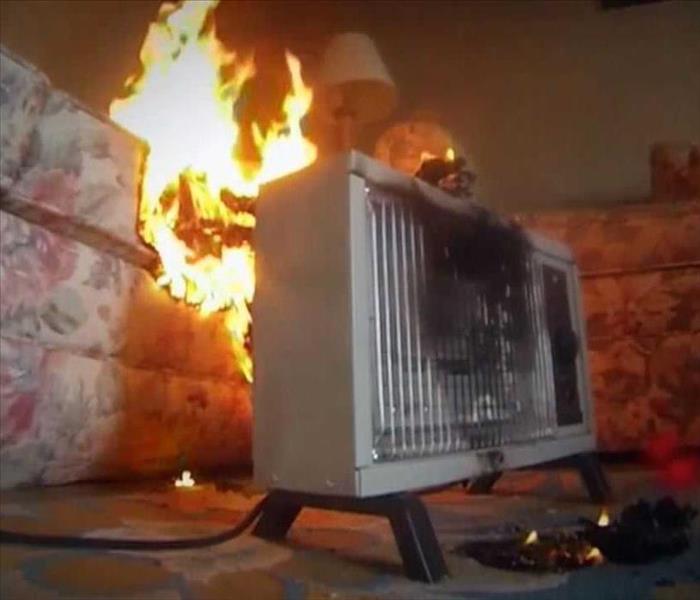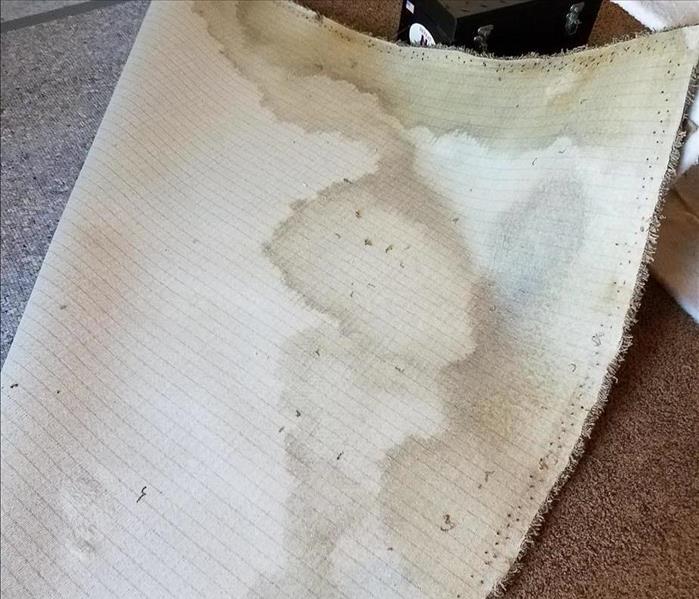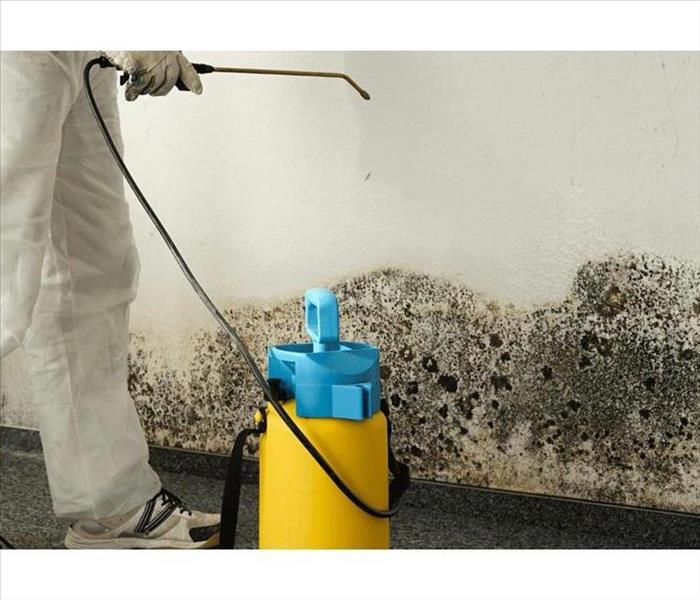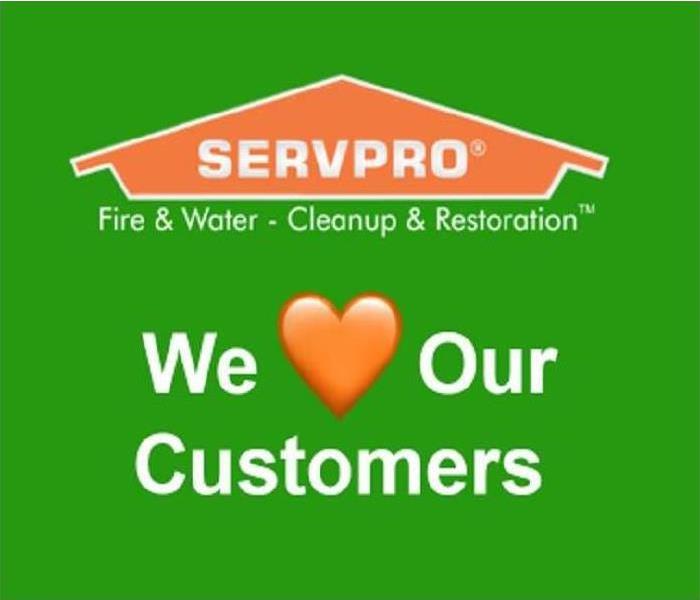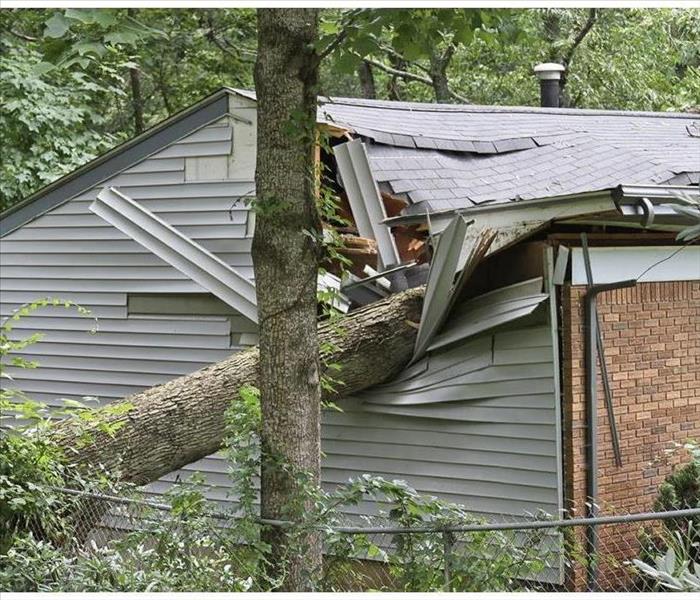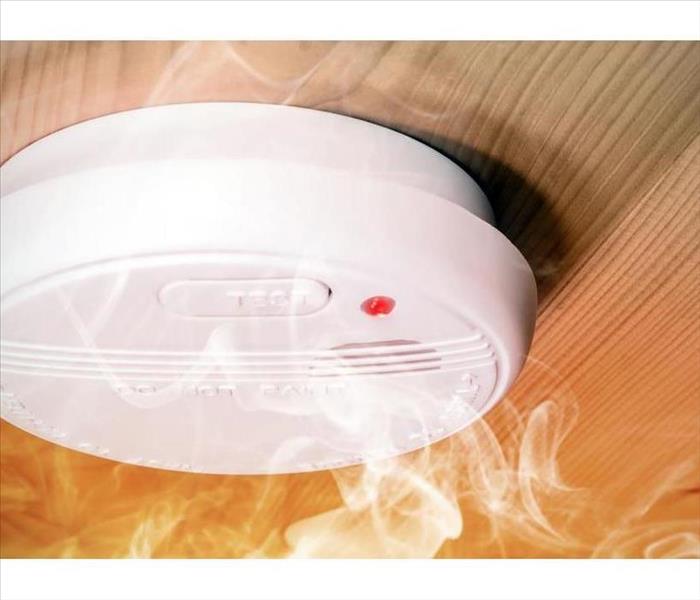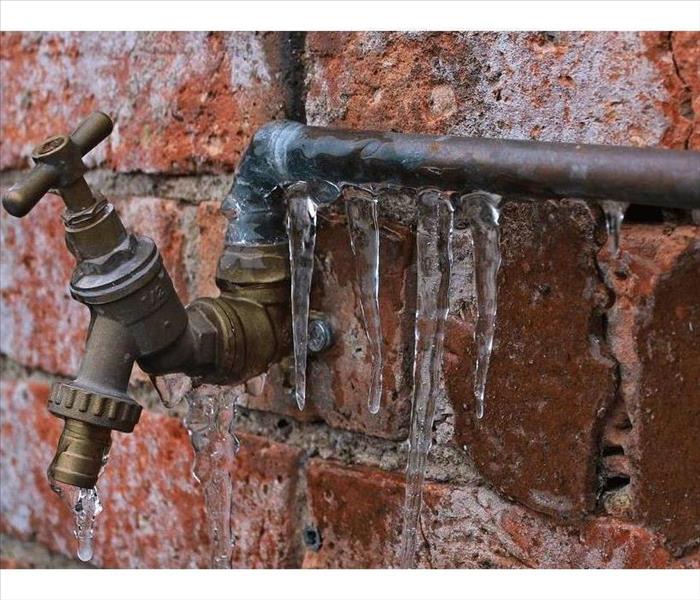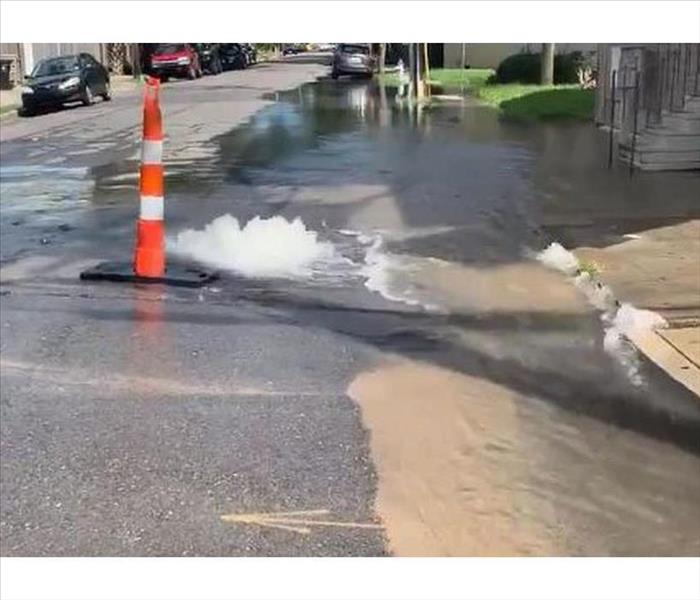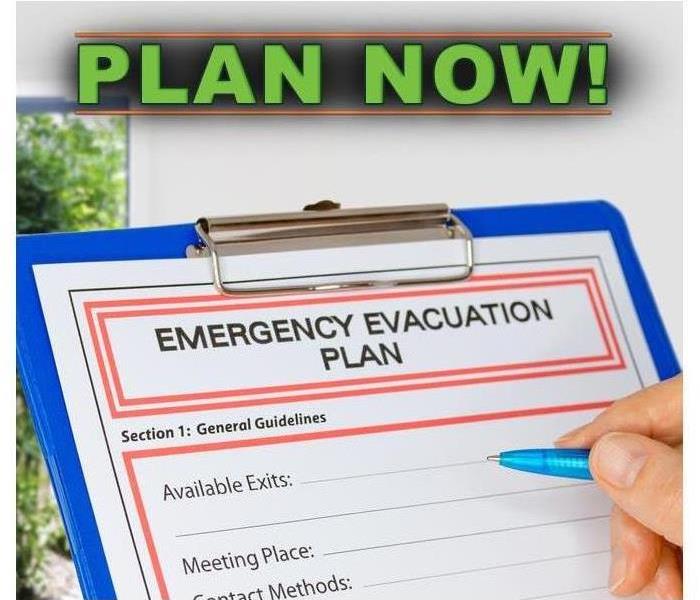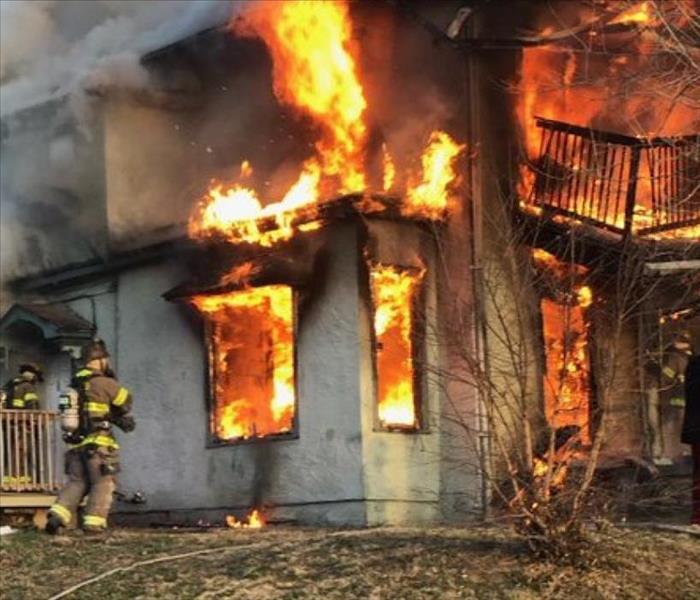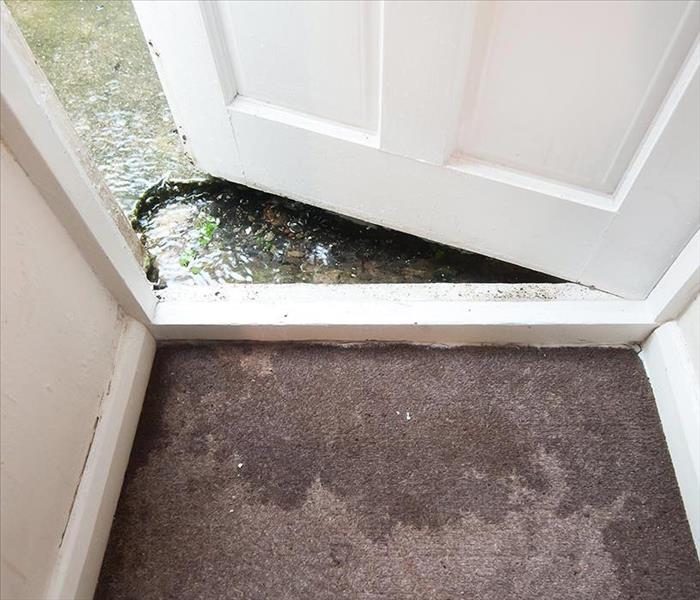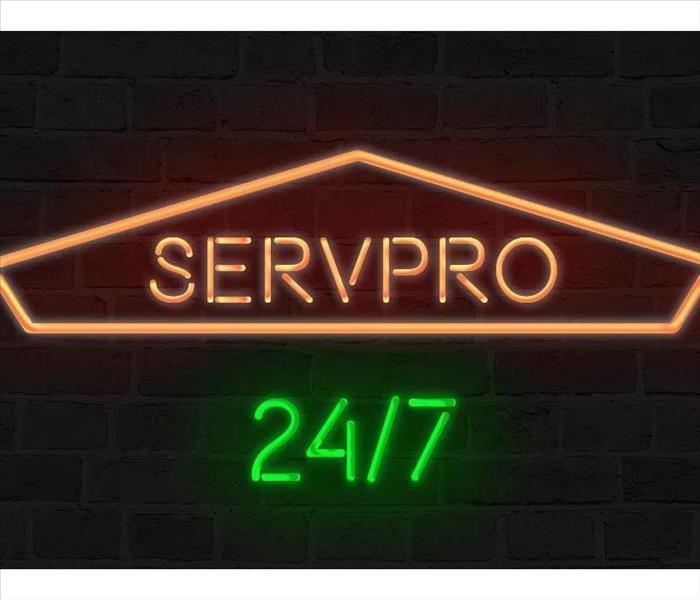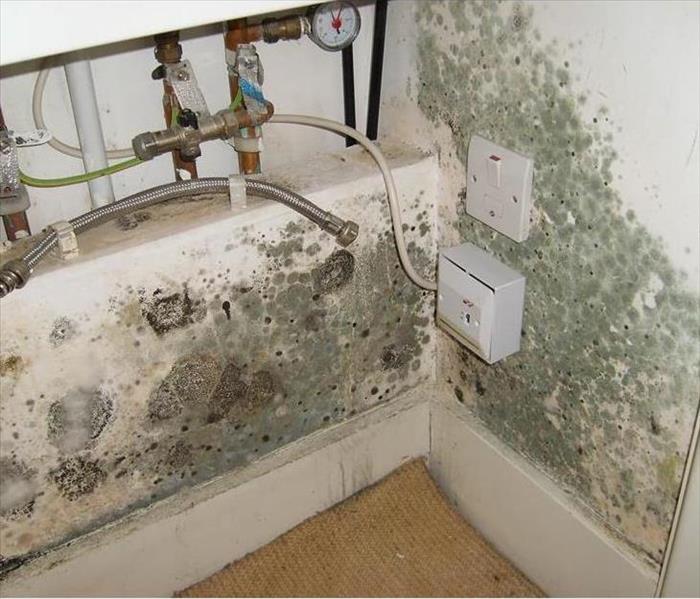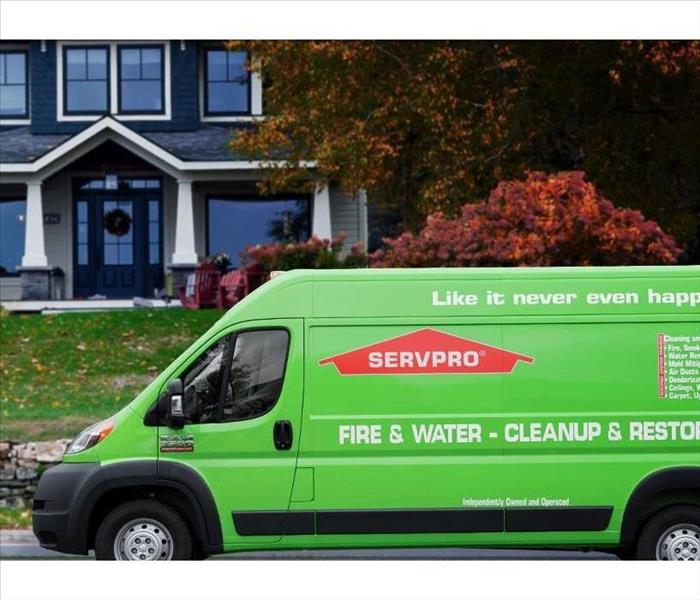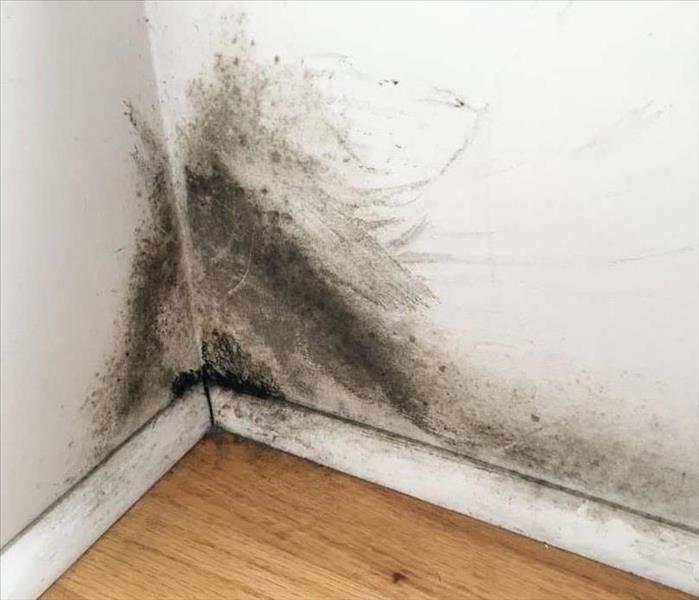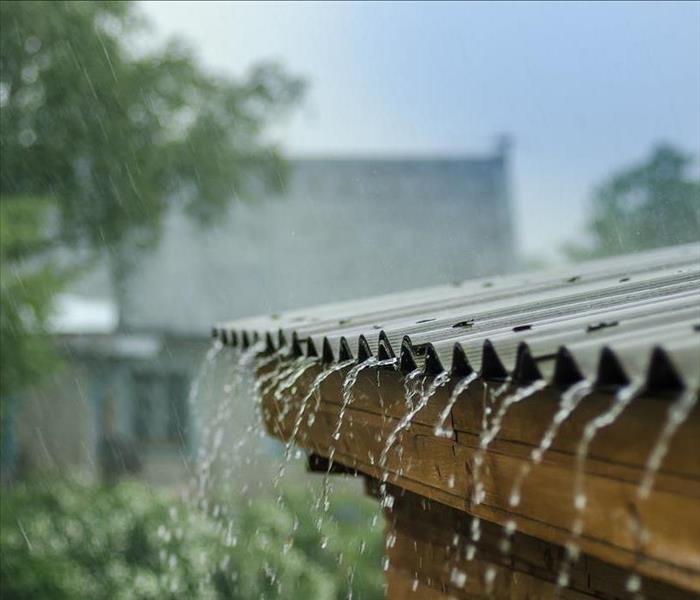Archived Blog Posts
Five Factors That Affect the Cost of Mold Removal
6/28/2022 (Permalink)
The cost of professional mold removal services for your home can become quite costly if not taken care of quickly and correctly. Here are five factors that will affect the overall price:
- Size of the Mold Problem
While you might be able to save money by tackling very small problems on your own, you will need the help of a mold remediation specialist for larger problems. Generally, the more widespread the problem is, the higher the cost
- Expense of Added Mold Testing
If you want a better idea of the levels of mold in your home and what species of mold is present, you can request a mold test at an added expense. A specialist should be able to address any type of mold growth that is found, including performing black mold removal.
- Location of the Mold
If the mold in your home is easy to access, such as on the surfaced of the wall or floor, you can expect to pay less for mold removal. However, if the mold is dwelling deep inside your walls or somewhere else that is hard to access, such as an attic or crawl space, the price will increase.
- Source of the Problem
What caused the mold to grow in the first place? If your mold problem was caused by a large underlying issue, such as a leaking roof or foundation issue, you will also need to consider the cost of addressing this issue.
- Cost of Required Restoration
If mold gets into the structure of your home, infects your carpet, or damages your belongings, the remediation specialist will complete the mold cleanup process and then fix any damage that has been caused. From replacing your carpet to completely rebuilding walls, these costs will certainly build up.
Dealing with mold removal can be costly, but it is a necessary process. As you prepare to call in a mold remediation specialist, estimate what you can expect to pay by considering these five factors.
3 Steps to Restore Your Business After a Sewage Backup
6/27/2022 (Permalink)
There are many different types of floods your business might endure, but few are more damaging than those that originate from a sewer. Black water, raw sewage and other contaminated contents can ruin building materials, stored contents, and office equipment. If you are currently dealing with this situation or want to be prepared for the future, you may want to become familiar with the steps a professional flood restoration company might take to restore your property.
- Mitigation
When professional flood damage technicians arrive, they will inspect the flooded areas and take whatever steps they can do to keep the sewer backup from spreading. For example, they will likely evacuate the rooms or the entire building so they can safely assess the situation before sealing off rooms or using portable sump pumps to drain away water that still might be flowing from contaminated sources.
- Building Material Inspection
Some building materials, such as drywall and insulation, are porous and can absorb sewage water. As such, an important part of the sewer cleanup process for your technicians is to inspect floors, ceilings and carpeting once the flood water is cleared to gauge the level of damage and which might need tearing out and replacing. Your flood specialists may perform flood cuts, which involves removing a section of a wall a few inches above the water line to know how seriously the interior and the components it contains might have been damaged.
- Restoration and Odor Removal
Sewage odor from a flooded toilet can linger long after the water has been drained away. Experienced technicians from a flood damage and mitigation service can give you several options for removing any unpleasant smells, from replacing floors and sections of drywall to ozone machines that cleanse the air and leave no trace of sewage behind.
When a sewer flood affects your business, the results can be devastating. However, understanding the process a professional sewer cleanup service may take to restore your building can help you feel confident about the results.
Why Does Mold Grow on Food?
6/27/2022 (Permalink)
Food is one of the most common places that mold can be found. Most people have seen mold on bread or food stored in the refrigerator for too long. The most common types of bread mold include cladosporium, penicillium, and rhizopus stolonifera.
Spores Are Everywhere
Mold Spores are present in air, soil, and water. As a result, food items are likely to be exposed to spores throughout the food supply chain:
- Growing
- Processing
- Shipping
- Sale
- Storage
Exposure to spores usually does not immediately cause fungus growth. Spores only settle and multiply in a suitable environment.
Moisture and Nutriment
Practically every type of food is a dense source of nutriment. Moisture and a food source are the two requirements for mold growth. The starches in bread break down into sugars, which sustain bread mold. Limited air circulation during storage at room temperature or in a refrigerator is also favorable for fungi.
Delaying Mold Growth
It is all but impossible to prevent mold from growing on food eventually. Delay growth by taking the following food safety measures:
- Cover cooked food as soon as possible
- Promptly refrigerate food
- Make sure containers and surfaces are clean
- Maintain low humidity levels
Even if fridge mold starts growing on one item, containment and cleanliness can limit cross-contamination. Throw away food as soon as mold growth becomes apparent. Some preserved foods contain mold that is safe to eat.
Mold grows on food for the same reasons that people eat food. Bread and other items are sources of sustenance. Bread mold usually does not indicate a major problem. If homeowners smell a musty odor or see signs of mold growth on building materials or contents, they should schedule a consultation with mold remediation specialists.
How to Prevent Mold After a Flood
5/27/2022 (Permalink)
A flood in your home or business creates nothing short of panic. It will get you running for the mop, towels, and wet/dry vacuum. Now that the standing water is under control, you will need to focus on mold prevention. Mold growth is an issue that needs to be addressed within 48 hours. Here are four ways to prevent mold after a flood.
- Remove Standing Water
A wet/dry vacuum can be your best friend. Safely removing water quickly is best to minimize potential damage. If you don’t already own one, it would be a wise investment.
- Remove Carpet
It’s very hard to dry carpet completely because the padding underneath isn’t exposed to the air. The water itself can damage your subfloor, and mold will grow within and under the carpet and pad.
- Remove Drywall
Drywall is often overlooked when a flood occurs because the focus tends to be on the floor. As water will spread along the wall it will start to wick up the baseboards and onto the drywall. Mold growth can occur within the wall cavity if that space isn’t dried properly, which usually means cutting out a portion of the affected wall.
- Remove Humidity
Moisture can seep into tiny crevices, making it difficult to dry everything completely. Mold and bacteria will be trapped in places that you’re probably not equipped to reach and don’t even think about. Humidity will be high after a flood happens, so being able to control that humidity with a dehumidifier can help the drying process.
When your home or business has flooded, start mitigation as quickly as possible to minimize damage and prevent mold growth. With the above tips, you can be sure to get your home back to normal in no time.
Fire Cleanup Process
5/26/2022 (Permalink)
If your home has been damaged by a fire, contacting a remediation company is a good idea. They can professionally remove fire and smoke damage from your home and help get everything back to the way it was before the incident. One crucial part of restoring your house is cleaning up your home and any damaged belongings.
- Removing Soot from Your Home
The first part of the cleanup process will be removing any soot from your home. Soot consists of carbon particles that are created during a fire and will likely cover walls, floors, ceilings, and items near where the fire occurred. A fire restoration company will be able to clean and remove the soot damage from the structure of your home.
- Cleaning Your Belongings
Some of your belongings may have fire damage that makes it difficult to save or restore them, but others might only have smoke damage that can be removed. Any items that can be salvaged will be cleaned during the restoration process to return them to the condition they were in before the fire.
- Removing Smoke Odor from Your Home
Once all the soot has been removed from the home and your belongings have been restored, smoke cleaning will be performed to remove any remaining odors. Smoke has a strong smell that can linger in your home after a fire, but fogging equipment and industrial air scrubbers can be used to get your home smelling clean again.
After a fire, it is important that you call a professional service to perform the cleanup process for you. Depending on the size of the fire there can be quite a bit of smoke damage that can be difficult for you to remove on your own. A fire restoration company will have the proper training and equipment to return your home to its prior condition.
4 Reasons to Have Your Business Professionally Cleaned After a Flood
5/26/2022 (Permalink)
If your business has recently experienced flooding due to a storm, pipe burst, or other cause you might feel overwhelmed trying to figure out what steps to take next.
The restoration process following a flood is often very extensive and may require the use of special equipment, especially if any mold growth has occurred. For this reason, you should always seek the aid of a flood and storm cleanup company. Here are important ways these professionals can help.
- Eliminate Foul Smells
After a flood, you might notice several different types of tainted odors in your building. Common odors include a musty or dirty stench caused by mold, the smell of sewage, or strong scents left behind by chemicals that have made their way into the flood water. A cleanup company can help by removing the source of the odor and using professional equipment to purify the air.
- Prevent Further Mold Growth
Improper cleanup after a flood can result in mold, which thrives on excess moisture. A professional crew can help remove mold that has already started to grow and prevent any spores from spreading.
- Protect Against Harmful Contaminants
Depending on the source of the flood water, your building might encounter harmful contaminants. If the flood came from somewhere outside of the building, such as an overflowing river, or resulted due to sewage loss, you need to call in the professions immediately.
- Preserve Important Items and Belongings
A flood can cause damage to important items such as important documents, expensive equipment, and personal belongings. By working with a flood cleanup company, you may be able to restore many of these items.
From pesky mold growth to foul odors, there are many ways flooding can affect your business. Make the cleanup process as easy as possible by getting in contact with a professional cleanup company right away.
How a Sump Pump Can Prevent Flooding
5/23/2022 (Permalink)
Water will always seek the lowest level, which in most homes is the basement. Because of this, flooding in basement can occur in many ways including:
- Drainage tile failure
- Cracked or burst pipe
- Hot water tank failure
- Storm sewer backup
- Foundation cracks
- Broken washing machine hose
When one of these issues happens, give SERVPRO a call. Acting quickly can help avoid further damage. One of the best ways to keep your basement dry and to prevent flooding in the fir4st place is by installing a sump pump.
Types of Sump Pumps
Sump pumps are small pumps that move water from your basement out of your home. There are two different types of primary sump pumps:
- Submersible – contain the pump and motor in one unit and sit submerged in a basin. They are quieter and less obtrusive but are harder to fix and a little more expensive.
- Pedestal – mounted above the floor and consist of a separate pump and a motor that cannot get wet. They are less expensive and easier to repair but are noisier and more obtrusive.
Submersible pumps are usually found in finished basements, whereas pedestal pumps are found in unfinished basements.
How Do Sump Pumps Work?
When pressure builds upon the foundation walls, cracks will form and allow water to leak through. Sump pumps are necessary because they remove water from around the foundation and not allowing that water to slip through. A sump pit collects water from around the foundation, and then pipes attached to the pump push water through a discharge pipe, out of the house, and away from the building. These pipes have a one-way valve to move the water in a single direction, which ensures water does not come right back up.
Sump pumps require electricity, so if a storm were to knock out the power, that would render it useless. A battery backup helps provide some extra security during a power outage. When the power goes out and water rises in the basin, the float switch is triggered and allows your pump to operate normally. Make sure to occasionally check those batteries!
Basement flooding can be costly to repair but losing personal items and family heirlooms can make it a tragedy. Make sure to waterproof your basement as much as possible and take the right preventative steps.
Three Steps to a Fire Escape Plan
5/20/2022 (Permalink)
Have you ever considered what to do in case of a fire at your workplace? When it comes to escaping a fire, having an emergency escape plan is necessary. Coming up with a fire escape plan is relatively simple, and it can help everyone escape from a fire quickly.
Post Escape Routes
During a fire, there is a good chance that one or more escape routes will be blocked. Because of this, you should have multiple ways for people to escape in case of a fire. If you are above the ground floor, avoid using the elevator. You never know where the fire has spread to, and you don’t want to wind up on a floor that is engulfed in flames. In addition, it can be dangerous because:
- The elevator’s power supply could be cut off during your ride
- This means that you can get stuck between floors
- It may be impossible to escape until help arrives
Always stick to the stairs during a fire.
Have Drills
Having fire drills can help you practice for the real thing. This can help you work out potential issues in your fire escape plan and cut down the amount of time it takes you to evacuate the building. Aim to have one drill every couple of months. Regular drills can keep the escape plan fresh in everyone’s minds.
Consider People with Special Needs
Anyone in the building who has a special need may need an alternate plan or someone to help them evacuate. Figuring this out ahead of time can prevent confusion and can help ensure no one gets left behind.
Putting together a fire escape plan is on of the best ways to make sure everyone gets out safely in case of a fire. While the fire repair specialists can get your workplace back in good shape, you will be able to rest peacefully, knowing that you helped get all your fellow coworkers out to safety.
Why is Flood Water Considered a Category 3?
5/19/2022 (Permalink)
Heavy rain and localized flooding can cause your neighborhood’s sewers to backup and overflow out of your sinks and toilets. This can cause feces, used toilet paper and other sewer contents to spill into your home. While you might be able to stop the flood temporarily by closing doors and stuffing the bottoms of the bathroom doors and towels, the condition of the water makes its removal by a qualified flood damage and restoration service a must.
Flood Waters Fall into Three Categories:
- Category 1 – comes from a sterile source, such as burst supply line
- Category 2 – may contain rinse water and detergent residue from a washing machine or dishwasher
- Category 3 – this water may carry human and animal feces, chemical waste, and other hazards
Outdoor floods that occur as the result of heavy rainstorms or other weather events are almost always Category 3, as rushing waters can pick up a variety of contaminants before they enter your home. A lot of times insurance companies under a homeowner’s policy will not cover sewage backups. They will require an additional rider to be added to the policy in order to have coverage for flood events. Make sure to take a look at your policy to see the extent of your coverage.
3 Ways to Reduce Your Commercial Fire Risk
5/19/2022 (Permalink)
Most people have never had to operate a fire extinguisher or flee a burning building, yet according to the U.S. Fire Administration, each year over one million structure fires cause damage to property. If you want to reduce the risk of fire damage for your business, follow these 3 simple steps:
Fire Extinguishers
The benefit of well-placed fire extinguishers can’t be overstated. The following facts about commercial fires illustrate importance:
- A high percentage of commercial fires don’t require an emergency response because an extinguisher was available
- Most business fires happen when workers are present, and a small fire can be handled with a good fire extinguisher
- Cleaning up a little bit of foam from the extinguisher is far preferable to the damage that can occur while waiting for emergency responders to arrive
Knowing where to store your extinguishers and how to use them are crucial factors in their effectiveness. It is essential your employees know where your extinguishers are located and their proper operation. Your local fire remediation specialist or fire department can help evaluate your site and recommend the number and placement of fire extinguishers.
Smoke Alarms
Commercial building codes require smoke alarms because they are your best chance of detecting smoke and fire in the early stages. A working smoke alarm and a good fire extinguisher can be a life saving combination. Consider including smoke alarms on your facility maintenance schedule. Backup batteries should be replaced every six to nine months, and the alarm exterior should be vacuumed occasionally to remove dust and lint.
Fire Sprinklers
Most regional building codes require fire sprinklers in commercial buildings. They may save your facility if a fire starts when no one is in the building. If no one is there to hear the alarms, the sprinklers can completely extinguish a fire or keep it at bay until emergency services arrive.
A small kitchen fire in your lunchroom doesn’t have a chance against the fire prevention triad: a working smoke alarm system, nearby fire extinguishers, and fire sprinklers. They can be the difference between a little smoke damage and costly commercial property damage.
Five Ways to Keep Mold from Coming Back
5/5/2022 (Permalink)
Even after black mold and other fungus varieties have been fully remediated, the growth can return. This is because mold remediation does not eliminate all mold spores. They are invisible and can be found almost everywhere. Fortunately, a little preventative maintenance decreases the chances of a re-infestation. The following are five ways to keep mold from coming back.
- Keep humidity low
Ideally, indoor humidity should be below 50%. In particularly humid rooms like bathrooms and basements, you may need to run a dehumidifier.
- Run an air purifier
Air purifiers with HEPA filters trap mold spores. Fewer mold spores circulating around your homes means a lower chance of them landing somewhere they can grow. You can also install HEPA filters in your HVAC system or use a vacuum cleaner with a HEPA filter
- Use mold-resistant products
Toxic black mold is usually found in water damaged insulation, drywall, or other building materials. If your home is prone to mold growth, you may want to replace these materials with mold-resistant alternatives. Additionally, you can apply a mold-prevention product such as a mold-control spray or mold-resistant primer.
- Clean up spills and water damage immediately
In many areas of your home, all that is needed for mold to grow is a little moisture. Therefore, it is important to clean up water, everything from small spills to large appliance leaks, as quickly as possible to prevent growth.
- Check for mold frequently
Check mold-prone areas of your home frequently to spot any mildew before it becomes a large infestation. Mold cleanup is easier and more effective if the growth is caught early.
Even the most thorough homeowners can experience a mold re-infestation. If the problem is too large for you to handle alone, a certified restoration company can help you get your home back to normal quickly and safely.
Creating an Inventory Is a Great Way to Plan for Fire Damage
5/5/2022 (Permalink)
Almost everyone these days has a smart phone. This can come in handy when it comes to fire damage. Go through your home and take video inventory of all your valuable items. This will help you realize what is lost after the fire. It’s a great idea to update your homeowner’s policy with newly purchased or received items that hold some value. This way, incase something does happen, they will have proof of bigger ticket items being owned and stored in the home that were lost in the fire. They will then be able to provide you with replacement options.
SERVPRO of West Hills can assist with fire damage restoration services for commercial or residential fire losses. We will also help inventory all damaged items into categories of salvageable and non-salvageable. All contents must be attempted to be restored before the insurance company can provide a replacement value them.
We pride ourselves on being faster to any size disaster. SERVPRO is open 365 days a year including weekends and holidays.
To learn more about our fire damage services, click here.
To check out some fire damage tips for what to do and what not to do, click here.
Feel free to give us a call if you have any questions or are looking for an estimate. (412) 299-5520
Common Pipe Noises and How to Address Them
5/4/2022 (Permalink)
A noisy pipe is not just an inconvenience. It could also be evidence that something is wrong with your plumbing system.
If the problem is not addressed, it could lead to a pipe break that causes major damage to your home. Some common pipe noises are:
- Banging
- Hammering
- Whistling
These sounds each signal a potential issue with your plumbing system. Below is a discussion of the causes of these noises and how to address them.
Banging and Hammering
Banging or hammering occurs when there is a sudden stop in the flow of water. Momentum causes the water to slam against the sides of the pipes. This can damage the joints and connections, which can lead to a pipe burst.
To combat this issue, start by inspecting the pipes for any signs of vibration or looseness. If your pipes bang against the wood while vibrating, you can install a rubber pad between the wood and the pipe to reduce the noise.
You can also try installing an air chamber, also called an anti-hammer device. There are several different types, all of which fill up with air that absorbs the sudden increase in water pressure. This, in turn, reduces the risk of a pipe break.
Whistling
Your pipes may make a whistling noise when water flows quickly through an obstructed area. This can occur when a faucet is running.
To determine where the noise is coming from, turn a faucet on and see if you hear the whistling. If you don’t, turn that faucet off and move on to the next one. Once you have found the source of the whistling, you can take that faucet off and move on to the next one. Once you have found the source of the whistling, you can take that faucet apart and replace the brass screw and the washer.
By performing the above maintenance tips in your home, you can avoid a burst pipe. If you do find yourself dealing with a pipe break, however, try calling water repair specialists. They not only fix a broken pipe, but they also can assist with the cleanup process.
Five Areas That Mold Can Be Found in Your Building
5/3/2022 (Permalink)
If your commercial building has experienced widespread damage due to a flood, it can be near impossible for you to track down all the areas that have been saturated with water. If water damaged areas are not addressed in a timely manner, mold growth can take over your building. To keep the situation from growing out of control, it is essential you get help from an emergency restoration specialist to remove standing water and stop mold in its tracks. Here are five common areas that mold can be found in your building after a flood.
- Flooring Materials
While wet flooring is a common place where mold can be found, it is often hiding below the surface where you can’t see it. Often, soaked porous materials, such as carpeting and certain types of hardwood floors, need to be discarded.
- Appliances
Mold and other bacteria may start to develop in the refrigerator after a flood, especially if the power went out for an extended period. Growth can also occur in ovens, dishwashers, and washing machines if the insulation gets wet.
- HVAC Systems
Mold growth in your HVAC system is particularly problematic. Don’t turn on your system until all mold is removal to keep it from spreading to other areas of the building.
- Walls
Water can saturate drywall and plaster, making its way deep into your building’s structure. Removal of affected walls is typically necessary to find and remove any mold.
- Furniture and Other Personal Contents
Furniture, office equipment, and personal belongings left in the building at the time of a flood can be a suitable surface for mold to grow on. A content cleaning specialist can be helpful for restoring any salvageable items.
What may start out as a small amount of fungus can spread quickly, thriving in areas that contain standing water and excess humidity. A restoration specialist can target mold growth in these areas and get your building back to its pre-flood condition.
Fire and Water Damage Go Hand in Hand
5/2/2022 (Permalink)
When firefighters extinguish the fire in your building, home, or business you will be left with both fire and water damage. As they put out the fire, massive amounts of water will be used to get this done and to make sure there are no hot spots left. This means that everywhere they hose off will be completely saturated and water damaged.
After the firefighters leave, give SERVPRO of West Hills a call so we can begin the restoration process.
We will first assess the damage and then begin removing all the damaged materials. We will then begin a pack out process to remove all your damaged items and take them to our cleaning facility to remove smoke odor and soot damage. Next is to start the drying process with our specialized equipment. Once everything is dried, we can start the major restoration work. Before you know it, your property will look “Like it never even happened.”
Ways Property Managers Can Prepare For a Storm
4/11/2022 (Permalink)
Here is a list of storm preparation tips that have the exterior of your building prepared to help you make sure your property is ready to withstand any storm.
Exterior Preparation Tips:
There are several steps property managers can take to ensure that the exterior of a commercial property is ready for a storm.
- Check the condition of exterior doors
• Clear roof drains, downspouts, and gutters
• Make sure no loose objects are left unsecured outside, such as antennas on the roof or trash cans on the ground
• Install storm shutters or board up windows for severe storms with high winds
• Use strong tape to make an "X" shape on the inside of plate glass to prevent shattering
Property managers should plan for adverse weather. Storm preparedness involves taking steps to ready the exterior and interior of a commercial property, as well as gathering important information.
Ways to Recover From Water Damage
4/11/2022 (Permalink)
Flooding, extreme weather and broken pipes can quickly cause a home to fill with water, threatening the integrity of a building in the process. Once the water is pumped out, it leaves behind a trail of damaged household items, some of which may feel irreplaceable. If you find that your home has recently suffered from severe water damage, it may feel overwhelming to navigate the process. The following are ways to ensure that you salvage the maximum amount possible and return your home to normal.
Remove Water ASAP
Leaving large amounts of stagnant water unattended to for days can lead to mold, which can quickly get out of hand. Flooding in the basement is especially dangerous, as it can result in the following problems.
- Mold, mildew, or fungus growing and spreading across rooms
- Damage to appliances, such as washer/dryer units or water heaters
- Cracks in the foundation of the house
- Electrical shock from contact with exposed wires
For minor fixes, such as a dripping pipe, a dehumidifier can clean the mess in a matter of hours. These can either be rented or purchased from a reputable dealer.
Contact Professionals for Major Cleanup
In a scenario where is simply too much water to remove through simple measures, professional restoration services can be contacted to take care of things. Restoration servicers specialize in water damage repair and know the best methods for restoring your home.
Dry Off Wet Items
After the water cleanup is completed, the restoration of recovered personal items comes into focus. In all cases, only trained professionals should handle electronics damaged by water. Air-drying works for most non-electronics, although not all belongings will be the same after suffering damage.
The dangers of stagnant water in a residence demand immediate and swift action. Finding and confronting water damage in a timely manner can get your family back on track as soon as possible.
What To Do About Hoarding
4/11/2022 (Permalink)
Where does all the stuff come from? And more importantly, how can we--as individuals and families--manage all the stuff?
Our SERVPRO Team Assists on Hoarders Clean Out
Our SERVPRO helps individuals and families when the stuff gets totally out of control. We assist on hoarders clean outs and estimates are free. Even now, with some many communications being electronic in nature, there is still a mountain of paper and things out in our Universe.
Some tools to help manage, or prevent, the buildup of stuff in our homes and worlds may be getting a home shredder and using it every single day in conjunction with the US mail delivery.
Also, remembering to send out boxes and magazines with bi-weekly recycle pickups can help diminish the pile up of paper. No recycle pick up? Magazines and periodicals can be donated to hair salons, etc.
Blocking out an hour of time a week, to go through things: clothes, shoes, knickknacks, papers, and other items, and being realistic about whether they are needed or used, and then unneeded items can be donated to charity, or perhaps friends or family may enjoy receiving the items.
Common Plumbing Materials and Their Uses
4/11/2022 (Permalink)
Learn About Your Pipes
Most people don't get curious about their plumbing until something like supply line damage comes along. If you'd like to be prepared before this happens, you should learn about your pipes. The type you have can tell you a lot about what kind of damage can happen or how long they will last.
Case Study: Plastic
There are a couple types of plastic you will find out there. The first is CPVC, which usually carries a warranty of 5-8 years. It is a rigid plastic prone to supply line leak at the joints and easy to damage, especially in a freeze. They are usually chosen because they are cheap and easy to install. An upgraded plastic option is PEX, with a warranty of 25 years. Some benefits are:
- Easy to install with fewer fittings
- Flexible so it can fit in small spaces
- Durable and corrosion resistant
- Can withstand temperatures ranging from 30 degrees to 200 degrees
Case Study: Metal
Copper was the industry standard for a long time, especially for exposed piping. It is still respected by most plumbers and lasts approximately 40 years. Soft copper can be bent to fit in tight places. However, pin hole damage is common to this type of pipe. It is also very expensive. If you have an older home, you may have galvanized iron piping. This type of pipe almost always falls prey to corrosion or rust and supply line damage and is not recommended anymore.
Case Study: Braided
Stainless steel braided supply lines are rubber tubes covered by a woven steel jacket. They usually come with a life-time warranty. They are extremely durable, and usually only cause a bathroom leak if damaged by harsh chemical cleaning supplies stored nearby. Also known as SS lines, they are very flexible and are corrosion resistant. Aesthetically they are very attractive- the woven metal appears like fabric.
Supply line damage can be repaired, but it may also be a blessing in disguise. A leak could uncover problematic plumbing that should be upgraded to something better. Get to know your pipes to keep your home running smoothly.
The Secret to Having a Reliable Fire Sprinkler System
6/30/2021 (Permalink)
Automatic fire sprinklers are an ingenious idea, designed to save lives and protect property. However, most businesses set and forget these systems, and that is where they go wrong. Neglected sprinklers are more likely to fail in the event of a fire, or cause water damage if they leak. Here are some of the things you could do to avoid sprinkler failure in your business.
Regular Sprinkler Maintenance
Sprinkler maintenance is the first step towards securing your property from a fire. For example, if you have a wet pipe system, there is a high chance water could freeze in the piping, resulting in a lot of pressure in that area. Such situations can break fittings or forcefully open sprinkler valves.
Other reasons for sprinkler failure include:
- Mechanical damage
- Corrosion
- Deliberate sabotage
You have two options when it comes to maintaining a sprinkler system – do it monthly or quarterly. Most companies in this line of work charge surprisingly low rates for this service, and it can save you thousands of dollars in return.
Use the Right Materials
Steel-based sprinkler systems are more likely to fail compared to CPVC systems. Metal gets corrosion and scaling over time, leaving it at a high risk of blocking. It happens when the metal’s ions break away after reacting with stationary water that has 6.5 PH or more. These particles build up in one spot, and that translates to more maintenance expenses.
Scaling is a result of water minerals settling to form a solid layer in the pipes. That limits water flow during a fire and can even clog the sprinklers completely. To avoid these complications, replace the entire system with a newer one that will not corrode or let the water freeze.
That said, it is essential to schedule regular sprinkler maintenance with a local company. It will not only save you from potential body injury claims, but it will also protect your business from a fire.
After the Storm: What to Expect During the Restoration Process
6/29/2021 (Permalink)
It can be difficult to comprehend the type of damage a violent storm can do to your home. Flooding, damaged building materials, and soaked furniture are just a few problems you may be dealing with in the wake of a storm. A professional flood damage company can help your home recover. Knowing what to expect during the process, from tear-out services to water drainage, may help you feel more confident about the outcome.
Storm Mitigation
When a powerful storm causes water damage to your home, it is important to contain the water. Preventing its spread can help reduce these future problems:
• Rapid mold growth
• Swelling and warping of wood
• High humidity
When a storm damage service arrives, they will likely act to prevent floodwaters from spreading to dry areas. Rooms that contain electronic components, such as fuse boxes or thermostats, may be drained first to prevent long-term damage to these systems.
Water and Debris Drainage
A storm restoration service will probably bring in a variety of machinery to drain away floodwater. When outdoor flooding invades your home, it may bring in not only water, but debris that includes dead leaves, mud, and garbage as well. Trash pumps and portable sump pumps can drain away this waste so your flood technicians can continue with tear-out services and other restoration actions.
Flood Cuts and Drywall Replacement
Because many building materials are porous, such as drywall, they can absorb and retain floodwater. This can cause rotting and damage to interior wall components, including insulation. Your storm damage and restoration service techs may perform a flood cut into the drywall about a foot above the water line to assess such issues and to gauge what kind of repairs might be needed.
When violent storms impact your home it can be difficult to know what to expect once repairs begin. Learning about tear-out services and other restorative actions may help give you peace of mind about the future state of your home.
6 Ways to Minimize the Risk of a Space Heater Fire
6/21/2021 (Permalink)
A space heater can be an efficient way to keep your home warm during frigid winter days. However, improper usage of a supplemental heating device can be dangerous. Six key safety tips can safeguard your residence from a burned space heater, a potentially damaging inferno, and a costly and time-consuming smoke cleanup.
Consider Safety Features
There are many models available on the market. If you have children or pets, consider purchasing a device with safety features, such as cool-touch housing or a tip-over protection switch that can automatically turn the unit off. With pets and kids running around you have the possibility of a space heater getting knocked over, and if there is no tip-over protection the heater will run and end up burning the material that it is set on.
Place in a Safe Area
Placing your heater in a safe location is also important. Avoid putting it in high-traffic areas where people may easily bump into it or trip over its cord. You should also ensure the device is several feet away from potential combustibles, such as curtains, newspapers, blankets, and upholstered furniture.
Check for Frayed Wires
Using any appliance with exposed wiring can result in an electrical fire. To avoid a burned space heater, you should routinely inspect your heater’s cord for damage.
Plug Only into Outlets
Although useful, extension cords can overheat. Because of this, you should avoid using them with your space heater. Plugging the unit directly into an available outlet is the safest option.
Do Not Place Objects on Heater
Because the space heater emits heat, it may be tempting to warm towels and clothing on the structure. However, draping any item over the unit represents a potential fire hazard.
Avoid Use in Damp Areas
Water and electricity can be a deadly combination. To alleviate the threat of electrocution, do not use a space heater in your bathroom. You should also avoid touching the device if your hands are wet.
No homeowner wants to endure a smoke cleanup or fire damage restoration project. Making conscientious decisions about how and where you use your supplemental heating source can spare you from a burned space heater and unintentional residential destruction.
Does Water Damage Ruin Carpet?
6/18/2021 (Permalink)
A pipe break, leak, or flood can ruin carpeting. Even if an incident involves clean water, prompt drying is necessary to prevent mold growth. Homeowners should consider the following factors when weighing the options of restoring or replacing flooring.
Water Categories
The extent of damage to the carpet depends on the level of contamination in water. Mitigation professionals classify water damage into three categories:
- Category One water is clean and treated
- Category Two water is contaminated but does not contain solid waste
- Category Three water is heavily contaminated and may contain solid waste
Carpeting saturated with Category One water from a pipe break can be dried, but it is important to mitigate damage quickly to prevent mold growth. Porous flooring exposed to contaminated water may run a higher risk of developing mold. Depending on the duration of time since the damage occurred, it may be possible to clean carpeting, or porous flooring material may need to be torn up, disposed of, and replaced.
The Condition of Carpeting
Carpet that has remained waterlogged for longer than 24 hours runs a higher risk of supporting mold growth. Moisture can penetrate to the underlayment and subfloor where hidden mold may multiply. It is important to dry every layer of flooring.
Advice From Restoration Experts
A service that specializes in cleaning up residential water damage can advise homeowners about whether flooring should be restored or replaced. Trained professionals will factor in the type of damage and condition of the flooring. It is important to allow the affected area to dry completely before replacing flooring.
Water damage caused by a pipe break can simply be dried if homeowners act quickly. Replacing carpeting exposed to contaminated water may be safer in the long run. Mold can result in costly damage to a residence. Seek a recommendation from a damage mitigation and restoration company.
Can Employees Go to Work During Mold Removal
6/9/2021 (Permalink)
Building or business owners may want to continue operating during mold remediation. It can be possible to do so depending on the containment methods in use and how much of a structure will be affected by mold removal. Owners should consider the following factors to provide employees with a safe working environment during remediation.
Confirm the Containment Strategy
The extent and type of mold present in a structure will determine whether containment is necessary. These measures will affect the portion of a building affected by mold growth that is being removed:
- Limited containment for contamination of 10 to 100 square feet
- Full containment for contamination of over 100 square feet
- Airlocks and decontamination chambers for major infestations and toxigenic species, such as black mold
If employees usually work in an area that is now contained, it will be off-limits during mold removal. These individuals should be relocated until remediation is complete.
Relocate Within a Structure or to a Temporary Location
Even if a work area is not within a containment zone, it can still be helpful to relocate staff to another part of a structure or a temporary location. As long as work can continue, a business owner should not need to make an interruption insurance claim.
Turn Off the HVAC
Air conditioning, heating, and fans can spread spores throughout a structure. Even if limited or full containment is in use with negative air pressure, an HVAC system may still spread preexisting spores throughout a structure. Climate control and ventilation should not be used until the main unit and ductwork have been cleaned.
Be sure to inform employees about the remediation process. Notifications about the mold removal schedule and safety measures can help to maintain productivity levels during this time. Building and business owners can trust that removal will be completed thoroughly and quickly by certified mold remediation professionals.
Replacing a Faulty Toilet
6/9/2021 (Permalink)
Day-to-day life can be busy and hectic. When your home is your castle, the last thing you want is a leaking toilet to turn into more than just a leak. It does not take time for a simple drip to turn into extensive water damage that can lead to mold and other issues. While sometimes a simple repair can fix the problem, replacing an old toilet may be the best choice for peace of mind.
Is It Time to Replace My Toilet?
When small issues only occasionally arise, a toilet repair may be all that is needed. If more signs keep popping up, it is best to not ignore them. Signs for a replacement may include:
- Clogging is consistent or randomly happens when it should not
- Visible cracks in the bowl or tank
Repairs are needed frequently or more than one is needed - Toilet was installed prior to 2000
- Noticeable wobbling or loose fixtures
- Excessive mineral buildup
Be Prepared Before Replacing
Before starting the process, it is important to be prepared. When buying a new toilet, measurements are everything. The rough-in for your existing toilet needs to be verified before purchasing. While most pipes are 12 inches from the wall, some models are closer or farther. Once you have your new toilet, be sure to have the tools necessary for the replacement.
Replacement Steps
When you are finally ready for installation, the process includes the following steps:
- Remove old toilet and clean the flange
- Snugly position and affix closet bolts against the flange
- Install new wax ring on flange
- Position new toilet over the flange, aligned with closet bolts
- Use washer and nuts to secure the toilet
- Ensure replacement is level and stable before attaching supply line
- Check fill line is met and caulk if needed
Although a leaking toilet and replacement may be relatively easy fixes, some people do not have the time or know-how to tackle the project. Luckily, there are many trusted professionals that can help including SERVPRO of West Hills & North Washington County. Give us a call at 412-299-5520 for a free assessment!
Is Flooding Considered Storm Damage?
6/8/2021 (Permalink)
Flooding may accompany storm damage, but storms may also result in other types of damage. The clearest distinction between the kinds of damage caused by a storm involves the fact that most general commercial property insurance policies exclude flood damage. A separate policy obtained through the National Flood Insurance Program or a private insurer may be necessary to cover this kind of damage. Find out more about how damage from floods or storms can coincide along with the firm distinctions between the types of damage that may occur to commercial properties.
Flooding From Rain or Rising Water
A flood is caused by external water. There are three common origins of floodwater:
- Precipitation
- Rising bodies of water
- Storm surges
Flood damage tends to involve contaminated Category 3 water. This black water may contain chemicals, heavy metals, and microbes and calls for cleaning and disinfecting.
Water Damage Due to Storms
A storm may cause floods or backup sewers, but other adverse weather conditions can also result in water damage. Hail, high winds, ice, and snow lead to any of the following types of damage:
- Broken windows
- Roof leaks
- Cave-ins or collapses
External moisture can enter a structure through damaged external doors, windows, or roofing. This damage may take the form of saturated or stained building materials and mold growth.
Flood and Storm Damage Restoration
It is necessary to extract contaminated water from a flood or storm, tear out ruined building materials, and clean and disinfect the area before promoting fast drying. This process may take several days, depending on the damage.
A commercial building owner or manager should determine whether a building has suffered a storm or flood damage. This categorization will determine whether the damage is covered by a standard property insurance policy or calls for flood coverage. Both types of damage necessitate similar mitigation and restoration measures. A one-stop-shop can quickly clean and dry any type of damage caused by water.
Controlling Mold Growth in Your Home
6/1/2021 (Permalink)

While mold damage can occur relatively quickly, most structural harm will come from prolonged instances of moisture buildup. Therefore, to prevent and control the level of mold development in your home, it may be necessary to perform regular inspections as well as install and maintain proper preventative measures.
1. Controlling Humidity
Mold and mildew growth are tied directly to moisture. One of the most advantageous times of the year for this type of fungus is in the warmer summer months when humidity is high. Therefore, as an extra layer of protection, you may want to install dehumidifiers around your home, especially in your basement and possibly attic where moisture levels are typically highest.
2. Ventilating High Moisture Areas
Extensive mold damage can be prevented in areas like bathrooms, kitchens, and laundry rooms by using proper ventilation. You can install ceiling fans and even ductwork that vents to the outside to minimize the amount of remnant moisture in these areas.
3. Sealing Your Home
A lot of mold growth occurs around windows, doors, and even rooflines. You can inspect these areas, looking for signs of sealant wear and tear. If you come across areas of yellowing or cracked caulk lines, it is in your best interest to replace the caulk before dampness infiltrates your framing and home interior.
4. Inspecting and Resolving Home Repair Issues
While surface inspections are easy enough, it can be beneficial to have annual inspections of your home to ensure that there are no hidden problems. You can call a mold remediation specialist and have your home assessed for possible damage. Many of these companies will offer a free assessment of your property and even provide you with a preventative plan.
Mold damage can be a costly problem that seems to come from nowhere but being vigilant about moisture control can minimize those risks. Installing dehumidifiers and ventilation systems can eliminate most environmental moisture problems. Also, scheduling regular inspections can help pinpoint issues before significant repairs are needed.
A Handful of Low-Cost Fire Alarms Can Help Save Lives
6/1/2021 (Permalink)
If you could spend a few bucks to be virtually certain your family would survive a home fire, would you? Installing a fire alarm in your house wherever it is needed is an incredibly cheap and effective way to accomplish this. There may be no more cost-effective method to mitigate your risk of death than installing the correct number of smoke detectors. These tips help make the most of these simple devices.
You Cannot Go Wrong Installing More Alarms
Strategically place the smoke detectors throughout the house. Experts strongly recommend installing a fire alarm in these locations:
- Every bedroom
- Outside every sleeping area
- Every level of the house
Do not forget the basement. Go ahead and install one wherever it seems logical. The sooner your family finds out about a fire, the better. A small fire can heat up other materials in a room. Once they reach a critical temperature, an event called flashover happens where the fire spreads to most surfaces instantly. Once this occurs, it is probably too late to survive the event. In a fire evacuation, every second matters.
Install Both Ionization Alarms and Photoelectric Alarms
A photoelectric fire alarm reacts quickly to smoldering fires before they can cause a flashover. Ionization alarms are better at catching fast-moving fires. With the prices so low, go ahead and get both kinds to ensure protection and reduce fire damage. Also, some detectors now include both types of sensors.
Modern Materials Drastically Reduce Escape Time
Tests run about 30 years ago indicated that people had approximately 20 minutes to escape a home fire. However, these days that number is reduced to three or four minutes thanks to materials that are subject to quick flashover. The best way to deal with this is to use new wirelessly linked detectors that will set all alarms off throughout the house no matter where the fire is detected.
If you have a fire, make sure to get a professional smoke damage mitigation company to do a proper cleanup. Smoke can leave highly toxic residue behind in every nook and cranny, and it takes expertise to thoroughly remove all traces.
The Facts About Water Damage
5/27/2021 (Permalink)
If you are a conscientious homeowner, you do your best to keep up with maintenance and necessary repairs. While there are things you can do to prevent disasters and emergencies in the home, you cannot always prepare for everything. Something such as a pipe burst or sewer backup can inflict widespread damage. It is important to understand these issues and how professional flood remediation teams can get your home back into good condition.
Typical Causes of Water Damage
Coming home and seeing flooding can be a nightmare. Water can find its way into the house in many ways. Even minor issues can turn into big problems. Here are some of the most common culprits:
- Roof leaks
- Broken or leaky pipes
- Leaky or bursting appliances such as a water heater or dishwasher
- Backed-up sewer
The Assessment
You should call a professional cleanup team and your homeowner's insurance company immediately after you discover a pipe burst or another cause of the flood. Cleanup crews will first inspect the home and determine the cause of the issue. The team will review the extent of the damage, come up with a restoration plan and share the timeline with you.
Removing the Water
Incoming water from a broken water line or severe weather can leave large amounts of water on the floor, walls, ceilings, and your belongings. Technicians will use industrial-strength machines to extract all standing water. Crews will also take the machines to furniture, carpet, and materials that are saturated with water.
Dry it Up
It is not enough to get rid of the water. A professional water removal team will also thoroughly dry the affected area. The technicians will use fans and dehumidifiers to make sure your entire home is moisture-free.
Sanitize and Rebuild
To keep mold away, the crews will disinfect all affected materials. For any materials the technicians can't save, they'll rebuild and restore your home.
Do not let a pipe burst or other problems keep you out of your home too long. A disaster relief company has the right processes and tools to make your house safe again.
How a Storm Can Lead to a Sewer Backup
5/18/2021 (Permalink)
It is not uncommon after a large storm to find out your home has a flooded basement. But how does this actually happen? There are a few ways a large storm can lead to sewer backup. Here are three of the most common.
Poor Drainage Around the Home’s Foundation
In many cases, flooding in the basement can be caused by poor drainage around the home's foundation. This is caused when drainage spout or landscaping sloped so that water can flow towards, and pool against, the home. Water can then get into the basement through cracks in the foundation. Fortunately, a local restoration service can help with any clean-up measures and recommend mitigation steps for the future including the installation of a sump pump. You may also want to consider ensuring that drain spouts and landscaping slope away from the home.
Sewer System Overflow Backing
In many cases, stormwater ends up in the sewer system. Whether this is from pipes designed to funnel water away from the home, storm grates in the city street, or drainage ditches, the system can fill to the point of overflowing and begin to back up into the home. This is one way you may find you have a flooded basement.
City Storm Drain Overflow
Many older homes in urban areas have pipes designed to funnel stormwater away from the property and into the city storm system. During times of heavy rainstorms, this system can become overburdened and the water can start backing up through these pipes into the home.
In many cases, a flooded basement can be caused by overflow from a sewage system, a storm drain system, or even poor drainage around the house. If you experience these problems, it is best to call a professional for an assessment and any recommended solutions. With proper mitigation steps, you can help prevent these problems in the future.
Your Insurance Adjuster Is a Big Fan of Organization
5/18/2021 (Permalink)
Feel sorry for home adjusters, especially when they come in teams to handle a regional disaster. They work long hours. Claimants are neither happy nor prepared. The list of water damage claims goes on and on. When they finally do sleep, they dream that they will one day visit an insured who is organized and ready to go.
Learn Where You Stand and What You Need to Do
You may already know everything there is to know about how your policy covers your home for water damage, but that is not enough. You need to have a good understanding of the insurance claim process and your responsibilities in it. Here are a few questions you should ask your agent or company in your initial call:
- What is the deadline for filing claims?
- Can temporary repairs to secure the home proceed?
- When can permanent repairs begin?
- What do you need for documentation?
- Will your insurance pay for you to relocate temporarily?
Hopefully, your insurer does not expect you to let the water damage continue to grow while you wait for a home adjuster. If they allow you to begin before the adjuster shows up, make sure that you understand the rules.
Be That Insured That Adjusters Dream About
Your adjuster needs copies of everything you can collect. If you can provide these items in an organized fashion, your adjuster will be ecstatic:
- Bills
- Receipts
- Digital photos
- Inspection reports
- Written bids
Also, the adjuster must have the opportunity to examine big-ticket items destined for the dump, if possible. However, bear in mind that no adjuster wants to inspect a damaged freezer full of food three weeks after the event. Dispose of the contents.
The Home Adjuster Approved Your Claim, and You May Begin Permanent Repairs
When it comes to repairs, it is always best to choose a company that works well with insurance companies. You will find such a team of water damage restoration experts nearby and ready to begin.
What to Do if Your Roof Has Been Damaged in a Fire
5/18/2021 (Permalink)
Sometimes a fire can be contained quickly, and the effects can be minimized. Other times, it can result in severe damage to your building. This can include broken windows as well as missing walls and roofing. When this happens, it is important to have fire cleanup and repairs done as quickly as possible to reduce potential secondary damage. If your roof has been damaged, the following steps should be taken.
Mitigate the Damage
The first thing that you should do is mitigate to prevent the damage from worsening. If parts of your roof are missing, you can contact a professional to have tarp services done. This will help keep debris from falling into the building through any holes in the roof. It will also prevent water damage in the event of a storm. In severe cases, using thin wooden boards in place of the tarp might be a better option.
Clean and Sanitize the Area
Before repairs on the roof can begin, fire cleanup will need to be done in the area. Because smoke and soot can create long-lasting odors, this should be entirely removed from affected roofing along with any debris. If the fire department puts the flames out with a hose, there may be some moisture trapped here as well. Make sure that the area is thoroughly dried and cleaned to prevent the growth of mold.
Make Repairs
Once the fire cleanup has been completed, repair work can begin. Any boards or shingles that have been damaged should be removed and replaced. The repairs process will include work on the appearance of the roof as well as its structure so that you will likely not be able to tell that a fire has taken place at all.
Roof repair after a fire is an important step in returning your building to its previous condition. To get the best results, call a professional cleanup and restoration service to do the work for you.
The Emergency Action Plan: Understanding the Basic Principles
5/14/2021 (Permalink)
How ready is your business for an emergency? Everyone should have a contingency plan in place because you never know when you will need it. You need to know that your employees are safe and accounted for in the event of a disaster. Therefore, you should understand the basics of an emergency action plan.
Make a List of Contacts
Every well-crafted evacuation plan requires a list of contacts. By ensuring contacts are regularly updated, you can keep track of people in a more thorough way. For instance, if your business is evacuated because of a fire, you can double-check counts to your list of contacts, and you can reach out to anyone not accounted for.
Designate and Assign Clear Evacuation Routes
An emergency contingency plan should include several exit routes designed to lead outdoors from every point in the building. Additionally, employees should be assigned a route that corresponds to their section of the building. This allows evacuations to happen in an orderly and predictable manner.
Design a Way to Account for Employees
You may also want to assign specific floor managers to specific exit routes, making them responsible for counting and verifying everyone assigned to their route. This will make accounting for all personnel easier, and it will allow a small group of managers to interact and check numbers.
Know Who Is Responsible for Reporting Fires
You should assign the task of reporting fires to specific people yet encourage others to call as well. By assigning the responsibility, you ensure someone reports the problem, but by encouraging others, you make certain that no one drops the ball.
Beyond reporting fires to emergency services and your insurer, you should keep a disaster restoration specialist in the area on file. These professionals may even set up an emergency plan with you, making the process that much easier. A proper contingency plan in the event of an emergency can be the difference between life and death. Keep your employees and yourself safe by planning ahead and seek assistance when and if you need it. SERVPRO of West Hills & North Washington County offer free assessments of your business’s preparedness, so give us a call at 412-299-5520 to schedule!
3 Types of Home Fires Not Covered by Insurance
5/5/2021 (Permalink)
A solid homeowner's insurance policy usually includes protection against home fire. While most plans cover nearly every scenario and fire damage, there are some incidents that cannot be included. These fires are usually either unlikely to occur or are often used for exploitation and financial gain. If you are a homeowner, you might need to learn more about these fires to prepare to work with an insurance agent and a residential remediation company.
- Vacant Fire
A common exception in general fire insurance involves a vacant home. While a vacant home fire can be defined differently by multiple insurance providers, a house is generally considered vacant if there are no inhabitants for 30 days in a row. So, if a fire occurs due to vandalism or a natural disaster in your uninhabited property, it cannot be covered. However, you can add separate vacant home coverage to your existing plan.
- Self-Inflicted Fire
Sometimes, a home fire may be caused by someone with the intention of hurting you or destroying your property. This is generally considered arson. However, in the insurance field, this term only applies to fires started by owners to make a claim. Insurance companies send investigators who collaborate with police to determine the cause. If the authorities discover a third party started the fire, it is classified as vandalism and you can make a valid claim.
- Unlikely Hazards
There are also other situations that insurance agencies cannot properly cover because either the loss is too great, or the causes are too unlikely to include in a general plan. The destruction caused by a war conflict or an incident involving nuclear energy is likely excluded from your policy. However, there are some agencies that provide additional, specialized coverage in addition to the regular risk areas.
Insurance for a home fire can cover a variety of factors, from natural disasters to vandalism. However, there are a few exceptions you must consider when choosing the right plan for your property.
Why You Should Worry About Mold After Flooding
5/4/2021 (Permalink)
How could water mean mold growth? It seems like something so ordinary, yet it is the catalyst of fungal spores. Therefore, for business owners, damage from flooding is a much larger issue than soggy carpeting. The longer the fluid sits in the establishment, the more likely you will have a bigger threat, and that could mean more time shut down and a larger restoration bill. Mitigate the situation by working swiftly and considering the following three points.
- Mold Loves Moisture
Microbial spores are everywhere. Your company has them on a daily basis. They make their way onto the premises through windows, doors, and you. In fact, you pick them up outside and bring them in. Usually, that means very little because they lack anything to make them grow; however, when standing water is permitted to linger, you provide the spark needed for development. Fungus only requires a few things to spread: water, organic matter, and itself. Add darkness to it, and you have a perfect storm.
- It Spreads Quickly
You may not realize that mold growth is fast. Within 24 to 48 hours, those little beings begin to multiply, eating away at the structure. Their function in nature is to break things down. Outside, that is a log. Inside, that is your walls, floorboards, and ceiling. Without a doubt, proprietors need to work immediately to prevent a major catastrophe.
- It Needs Removal
You will have to gut the place of any contaminated sections. The bacterial and fungal spores are trouble, and they will cause a shutdown. As an environmental hazard, people will not be allowed in until the place clears inspection. Hire a water and mold restoration company as soon as flooding occurs. Doing so, may limit reproduction or even prevent it from happening. They will tear out ruined areas, dry out the sections and rebuild what is needed.
Do not allow mold growth. Seek assistance as soon as you see flooding issues. This may keep it at bay.
How To Improve Claim Processing With Reliable Emergency Services
5/4/2021 (Permalink)
As an insurance agent or adjuster, you work to make sure clients are getting the compensation they deserve when disaster strikes their commercial property. Your claim services, however, depend on the efficient response of other entities. When you work with a reliable damage mitigation company, you can improve the speed at which you process your claims.
Reliable Scope
It pays to build a relationship with a company that specializes in various types of emergency response:
It is best to choose a company that not only cleans up the mess the disaster left behind but also restores your client's building to its former state. A company that includes both remediation and restoration in one fluid process will likely work well as a preferred vendor and help you streamline your claim services.
Reliable Response
Starting mitigation as soon as possible can help minimize the damage to your client's property, thus lowering the cost of repairing it. When you call the 24-hour helpline, local SERVPRO agents spring into action. Within a few hours, technicians can be on-site, assessing your client's property to determine what kind of mitigation is needed so that you can get the claim process started.
Reliable Service
With years of experience and skills training backing them up, the experts who take on your client's cleanup job can provide detailed reports of their progress. They remove unsalvageable materials, make sure the building is clean and dry to prevent secondary damage, and rebuild the affected area so that it is functional again. Many insurance companies choose SERVPRO as their preferred vendor because they know they can rely on the company's reputation for quality service.
You can improve your claim services by working with a trustworthy restoration company. You can depend on the reliable scope, response, and service with a certified remediation team.
3 Tips to Help Prevent Space Heater Fires
4/30/2021 (Permalink)
During the winter, many families use space heaters to keep their homes warm without increasing their energy bills. However, a burned space heater can quickly catch fire, and as a result, your home can sustain major fire damage. However, there are several ways you can reduce the likelihood of a space heater causing a fire in your home.
1. Maintain Your Heater's Filters
Over time, filters in space heaters accumulate dust and dirt. If the heater's filters are not cleaned, the heater may begin to emit smoke, making a fire more likely to occur. The fire and the smoke cleanup process can be costly and time-consuming, and many homeowners find it useful to contact emergency restoration services. However, frequently cleaning your heater's filters can help to prevent the heater from smoking and causing a fire.
2. Turn Off Your Heater When You Sleep and When You Leave the Room
In addition to cleaning your space heater's filter, it is also often best not to leave a space heater unattended. If you leave a space heater unattended, you likely will not notice signs that a fire may occur, such as smoke or sparks coming from the heater. Falling asleep while using a space heater can also be risky, as a burned space heater could quickly cause a fire, and you may not notice the fire until it has spread.
3. Position Your Heater Appropriately
A properly positioned space heater that is kept away from flammable items can help to reduce the likelihood of a fire occurring. However, a space heater that is positioned too close to other items, such as blankets or clothes, is significantly more likely to result in a fire. It is also often best to place your heater on a sturdy surface that is not made of plastic or other materials that may melt.
Knowing how to safely use a space heater can offer you peace of mind during the winter. You can often prevent a burned space heater from causing a fire by maintaining the heater's filters, turning off the heater when sleeping or leaving the room, and keeping your heater in a safe position.
5 Ways SERVPRO’s Claims Inventory System Can Help Your Business
4/29/2021 (Permalink)
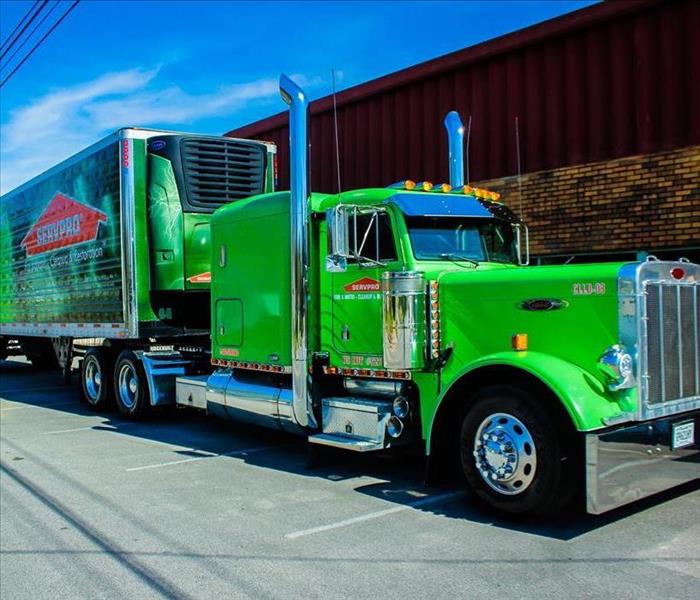
When you make an insurance claim for your business after it suffers a disaster, your insurance agent may recommend working with a local SERVPRO for restoration. One of the reasons for choosing this service is the use of their electronic inventory system. There are several ways the use of this system can help the restoration process.
1. Keeping Lists
In many cases, a claim requires a list of damaged items for review. This database can store these lists and allow your restoration team to update them as they assess the damage.
2. Storing Photographs
Photographs of the damage may also be required for the restoration. This database can also store these so that they remain with the relevant damage list.
3. Remote Access
Another benefit of using this system to help with your insurance claim is the fact that it offers remote access. This allows you or your agent to stay up to date with the restoration without having to play phone tag or visit the job site.
4. Electronic Database
One of the benefits of an electronic database is that all the information can be stored in one place without having to compile tons of paper documents. It also reduces the risk that relevant paper documentation may be lost or damaged.
5. Progress Reports
Another aspect of the electronic database is that it can keep track of progress reports. This means that as aspects of the restoration are completed, the workers can update the progress file, allowing you to know what has been accomplished.
Working with SERVPRO’s electronic claims system can help with your insurance claim in several ways. This system can keep track of lists and photographs, as well as store progress reports. It also offers remote access allowing you to know what is going on from any location where you can lot in. In addition, the electronic database helps prevent the loss of paperwork.
Is Your Company Covered for a Mold Claim?
4/28/2021 (Permalink)
The right amount of general liability insurance for your company protects you from life's unexpected moments. One of these surprises could be the presence of mold in one or more corners of your property. What exactly, though, will your insurance cover for a mold outbreak? Mold insurance claims are often downright confusing, so it is always a good idea to have a detailed discussion with your agent at least once a year. Policies and coverage can change without warning, so it is best not to assume you have extended mold coverage for your business.
Beware of Exclusions
Mold exclusions in policies began showing up in the 1990s in response to some hefty awards handed out to policyholders. It is called a "fungus exclusion" and puts limits on the following mold insurance claims:
- Loss or damage caused by mold
- Loss or damage caused by dry rot or bacteria
- Loss or damage caused by mold spores, toxins, smells, and by-products of fungi
Property owners can still collect on a mold claim through a few exceptions to the fungus exclusion. A term known as Limited Fungus Coverage applies to the cleanup and repair of damage caused by a mold outbreak. In short, reasonable expenses for mold remediation are allowed in these cases.
Watch Out for Policy Changes
In addition to speaking with your insurance agent, ask about the availability to pay higher premiums for more robust coverage. In all cases of mold growth, call in a mold mitigation team that will arrive and begin the remediation process. A mold outbreak moves quickly, spreading through the HVAC system and other pathways. A rapid and professional response cuts down on costs. You can limit your mold insurance claims with prompt action and keep expenses and damages below the $15,000 normally approved for damages. This limit for damages is an annual limit and includes expenses associated with mold mitigation.
Six Essential Steps For Sewage Cleanup
4/27/2021 (Permalink)
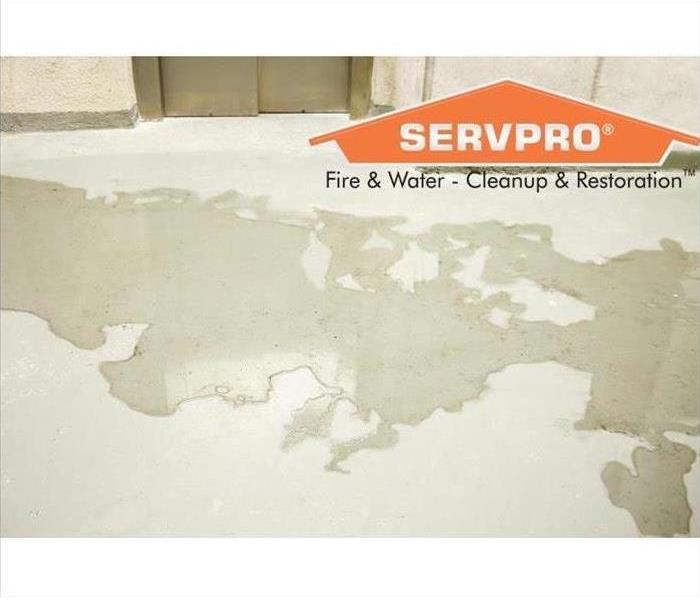
Whether due to a flooded toilet or a backed-up sewer line, unique cleaning procedures are required to ensure the building is properly sanitized. Additionally, special equipment, gear, and precautionary actions are needed to avoid harm to the individuals cleaning the harmful toxins and bacteria. For this reason, it is important to always hire a water and sewage cleanup company to deal with this situation. Here are the steps that the specialist will take when cleaning the area.
Preparation and Inspection
The specialist will begin by preparing the area and inspecting it to assess the extent of the damage. The preparation process will include completely evacuating the area and putting on the necessary gear including coveralls, rubber boots, rubber gloves, and eye protection.
Removal of Water and Sewage
Next, the specialist will use pumps and vacuums to remove all standing water and sewer backup from the area. This prevents even more damage from occurring.
Removal of Contaminated Surfaces
After the water is removed, the specialist will continue with sewage cleanup by removing flooring, walls, and other surfaces that have been contaminated. Items that can be restored will be separated for later cleaning.
Professional Drying
Once all damaged surfaces and items are removed, dehumidifiers, air movers, and other professional equipment are used to dry the area. This can take several hours or even days to finish.
Cleaning and Sanitizing
The specialist will then thoroughly clean and sanitize all salvageable items and areas. In addition to removing harmful bacteria, this process might include mold removal and deodorization.
Restoration and Reconstruction
Last, the specialist will work on restoring your business through reconstruction and replacement. This can include installing new walls and floors, replacing furniture, and repainting surfaces.
All these six steps of the sewage cleanup process are necessary for safely restoring your building and resuming business as normal. Calling an experienced water restoration company is the best place to start.
We Can Handle Any Size Water Loss
4/23/2021 (Permalink)
What do you do if you have a massive water loss in your business? The best choice is to call SERVPRO of West Hills & North Washington County immediately to begin the water extraction process. Once on-site, a dedicated member of our team will start to scope the project and give you a time frame to get the job done.
It is so important that you make sure the water is removed from the building as quickly as possible. Failure to do so can result in other forms of microbial growth. This can cause a more expensive mitigation job as well. SERVPRO of West Hills & North Washington County has the team and equipment to make sure the job is done right from the very start.
Once all the water is removed, SERVPRO of West Hills & North Washington County will begin to place all drying equipment to get the job dried. Each day the job will be carefully monitored from start to finish. After the structure is dry, SERVPRO of West Hills & North Washington County will remove all equipment and help with any necessary repairs.
If you have any questions, do not hesitate to reach out to us at 412-299-5520. We are always here to help.
How to Prevent Mold Growth After a Flood
4/22/2021 (Permalink)
If you have had a storm and your business or home was damaged, you should act quickly to keep your building from being affected further. Mold growth can occur quickly, sometimes overnight, when water is not removed. To prevent this fungus from spreading, take the following steps.
- Start Mitigation Quickly
One of the first things that you should do is to contact a professional service to begin work on mitigation. This stage takes place before restoration and is done to keep damage from spreading or getting worse. Standing water will be removed, and the area will be cleaned.
- Dry Everything Thoroughly
Because mold growth happens in areas with excessive moisture, just removing the water is not enough to keep it from spreading. Opening windows and doors can help the air circulate and speed up the process. A dehumidifier can also be used.
- Replace Damaged Materials
Due to the high levels of bacteria, sewage, and other contaminants such as mold spores found in flood water, it is difficult to clean materials that have absorbed them. Insulation, drywall, and padding beneath carpeting will more than likely need to be replaced.
- Have Belongings Cleaned
The building is not the only thing that can be affected by mold after a flood. Furniture, curtains, and other items made with porous materials can easily grow the fungus as well. If the damage is not too severe, you may be able to have items cleaned in a washing machine or by dry cleaning. For others, a professional service may be able to salvage them with more advanced machines.
Mold growth can occur very quickly, so you should begin work to have water damage removed right away. A cleanup and restoration company will be able to get the job done quickly and thoroughly. They can remove excess water from the building, inspect for mold and other damage, and make repairs to return your building to its previous condition. “Like it never even happened.”
Three Main Types of Mold Tests
4/20/2021 (Permalink)
Have you noticed a fungus growing in your home? If so, you need to determine if it is mildew or something more serious, such as mold. You can do this by performing a mold assessment.
Mold can contaminate your house in a short amount of time. Black mold can cause extensive damage. While mold cleanup is possible, you first need to test your home to determine the extent of the problem. There are three main types of mold tests.
- Air testing checks for spores within the air of your home
- Surface testing analyzes mold samples from household surfaces
- Bulk testing examines larger materials in your home for possible mold contamination
When To Test for Mold
You should perform one of these tests if you smell a musky odor in your home. A mold assessment can confirm the presence of the fungus and tell you where the contamination is located. You may also want to test for mold if your house recently suffered a water leak or flood damage.
Tests can also help you identify the species of mold in your home. After all, knowing what type of spores you are dealing with will make the mold remediation process easier.
How To Test for Mold
If you want to test your house for mold, you should contact environmental hygienists or certified mold specialists. They can safely locate the mold damage and accurately analyze the findings. However, you can also purchase mold testing kits in a store. The kits will tell you how to collect mold samples and send the spores to a lab. For best results, you should perform air, surface, and bulk testing. The tests should take place at different times and in different areas of your home. Of course, performing a mold assessment is just the first step. If tests reveal that there is excess mold in your home, black mold cleanup specialists can remediate the situation. You should then perform another test to ensure the problem is under control.
3 Reasons to Choose SERVPRO
4/6/2021 (Permalink)
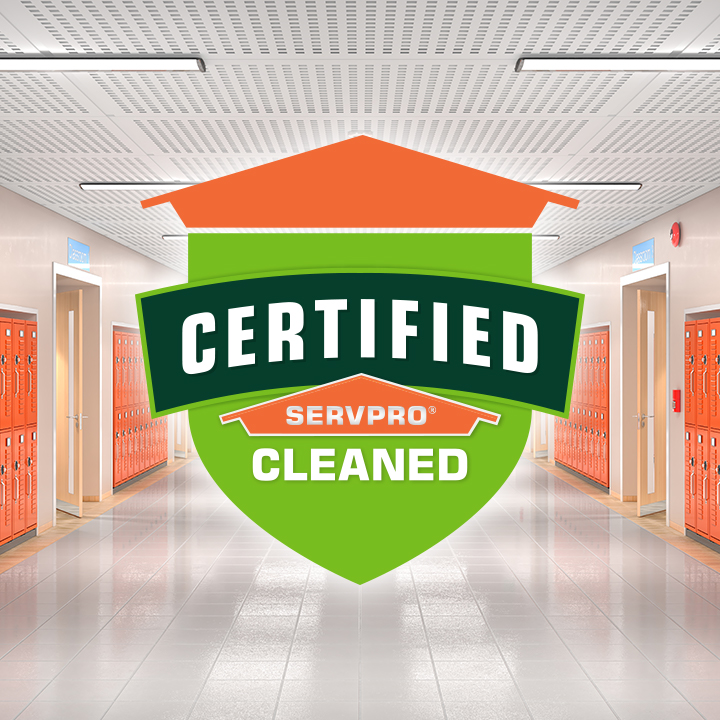
If you have a client with property needing restoration, then you may want to consider recommending a SERVPRO franchise in their local area. This professional restoration service may be able to provide the right team to take care of multiple restoration needs. Here are a few reasons you may want to consider them.
1. They Are Trained in Multiple Damage Types
The individuals at SERVPRO are all certified to perform a variety of restoration jobs. This allows them to assess and repair any damages they may find regardless of the source, whether it is water damage, fire damage, mold remediation, or storm damage. This means that on occasions real property has suffered more than one damage type, a single team of restoration professionals can still conduct repairs.
2. They Offer Excellent Service and Results
The SERVPRO franchise is locally owned and operated, meaning that you can often find a service in the vicinity of your clients. This allows for a quick response time. A restoration team can quickly be on the property and begin assessment and planning for the repair process. Their teams pride themselves on providing quality service in every aspect of the job.
3. They Can Help With More Than Building Repairs
These restoration professionals are in areas other than repair. They also offer document restoration, an electronic inventory management system to help insurance companies, item restoration, protective boarding and tarping services, and may even help with security measures for large commercial properties under repair.
If you're looking for a restoration team with excellent service, quality results, and great customer service, then you may want to choose the SERVPRO franchise. These restoration professionals are trained in multiple damage types including fire, flooding, storm damage, and even mold remediation. They even offer a variety of services outside repairs. The variety of services offered, and the ability to deal with multiple types of damage, allows you to recommend a single service to your clients for whatever disaster may have occurred to their property.
Winter Storms & Polar Vortex Preparation
2/23/2021 (Permalink)
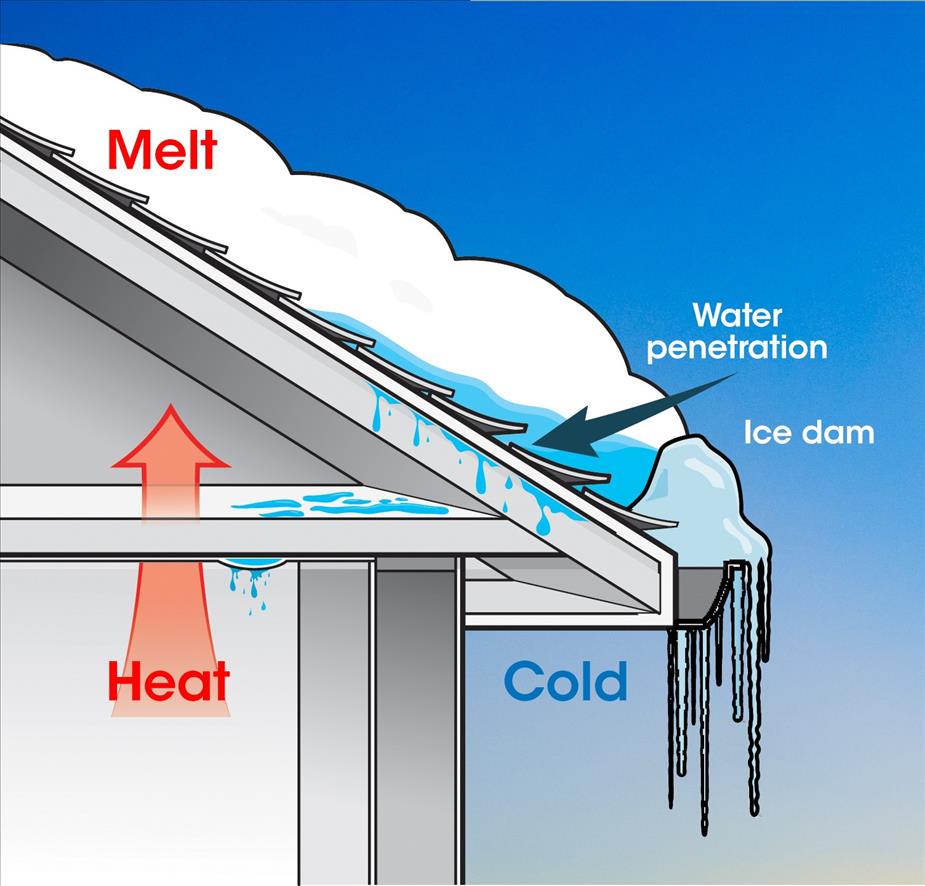 How ice dams are formed.
How ice dams are formed.
There is always talk this time of year about when the next “polar vortex” is on the way, but what is this phenomenon? A polar vortex is a large area of low pressure and cold air surrounding both Earth’s poles. During the winter, the polar vortex will expand and send cold air south with the jet stream. Arctic air can bring abnormally low temperatures to places that do not typically get too cold. This can cause complications in buildings if precautionary steps are not taken. When colder temperatures hit, people will prepare themselves with hats, gloves, and warm clothes. That level of preparation should also take place for homes and businesses.
Problems that can arise during these conditions:
- Ice damming happens when indoor heating melts the snow on the roof above a conditioned space forcing water to move to and freeze on the roof eaves. A ridge of ice then forms and prevents melting snow to drain off the roof, thus allowing water to move into the structure through cracks in the roof.
- Problems with the foundation can be caused by a frost heave, which is when freezing temperatures and water penetrate the ground, forming ice, and then forcing the soil to swell and push up against the foundation. Added pressure on the foundation walls can create cracks in the concrete where water can seep through.
- Frozen pipes occur when the temperature is cold enough to freeze the water inside of the pipe. Water molecules expand when frozen to create a blockage of ice within the pipe causing unfrozen water to build up and increase pressure on that pipe. An increase in pressure can thus raise the chance of a pipe rupturing.
From all these scenarios, water damage can appear inside and possibly lead to the growth of mold. Keep an eye on any problem areas you may have to make sure things are not worsening.
Steps you can take to prepare:
- Make sure your top floor or attic is well insulated.
- Try to clean the snow off your roof as much as possible.
- Wrap pipes with added insulation.
- Seal in any foundation cracks.
- To avoid freezing, let your faucets drip to keep water flowing.
- If ice damming is a reoccurring issue, install heat cables along the edges of the roof.
- Shut off exterior water sources that are not insulated.
- If you are away for an extended period, keep temperature in the structure at 55°F or higher.
Make sure to have extra supplies and to stay informed on weather events coming to the area. It is best to be proactive during the winter months because you never know what mother nature will bring!
3 Ways To Prepare Your Business for a Winter Storm
6/26/2019 (Permalink)
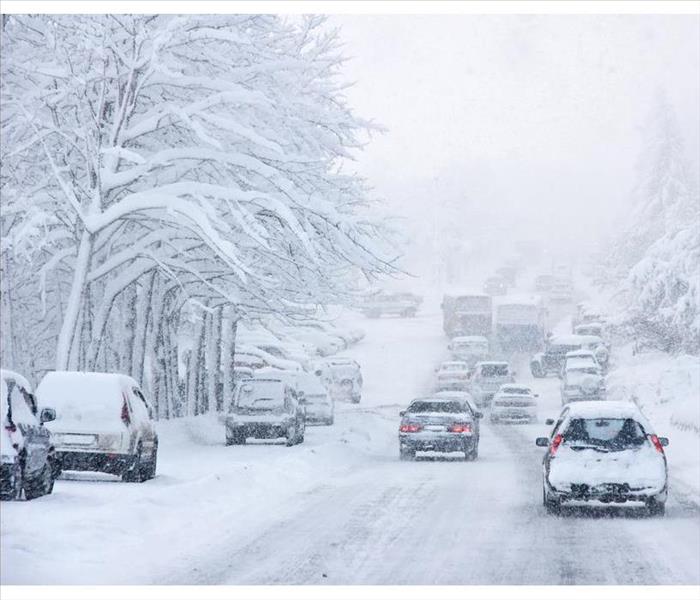 A winter storm has the potential to devastate a business
A winter storm has the potential to devastate a business
Prepare Your Business Prior to a Winter Storm
A winter storm in Fayetteville, PA, can wreak havoc on businesses, and many people are unsure how to prepare their businesses before a storm occurs. However, making preparations prior to a storm can ultimately save you time, money and stress.
1. Examine Your Building Prior to the Storm
Burst pipes, structural damage and water damage can often occur after a storm. Examining your property before a storm, however, can help to prevent such damage from occurring. If you examine your property prior to a storm, you are likely to notice any small issues, such as a pipe leak or cracks in the structure of your building, that could make storm damage more likely. If you notice any problems that could result in major damage, you have the chance to fix the issues before the storm hits.
2. Back Up Important Documents
A winter storm can often cause a power outage in your building, which can make it difficult to access important documents you may need. Before a storm, it can be useful to back up important documents by uploading documents to a cloud or a hard drive. Additionally, making physical copies of documents that you might need during and after a storm can be helpful in case you don't have access to the internet.
3. Be Prepared for Snow Removal
Storms can often result in businesses sustaining structural damage. Though removing debris from your building and inspecting your property prior to a storm can be useful, structural damage can still occur and snow removal is often still necessary. If you know a storm is likely to affect your area, it can be useful to look for disaster restoration services you can contact if you need assistance after storm damage has occurred.
A winter storm has the potential to devastate a business. However, knowing how to prepare for this type of storm can pay off by preventing your property from sustaining major damage.
What is the fastest way to dry a large commercial space after it gets wet?
4/29/2019 (Permalink)
If you have a large water loss, it is critical to hire a professional restoration company immediately like SERVPRO of West Hills. There team is faster to any loss, and can help with each step of the project. From the initial emergency services, to the final repairs, SERVPRO of West Hills is the one company you can trust.
Each day the men and women of SERVPRO of West Hills wake up with the intention to help you through a tough time for your business. We understand the stress and frustration with dealing with all types of water damage. Our goal is to mitigate the damages and get your business back to pre loss condition as soon as possible.
If you have questions, we encourage you to reach out to SERVPRO of West Hills at anytime. We pride ourselves in being an educational resource to help you from start to finish. No job is too big for our team and we have the resources and experience to make sure the job is done right. If you have any questions call us anytime, 24 hours a day.
Faster to Any Size Commercial Disaster
4/28/2019 (Permalink)
SERVPRO of West Hills is the fastest company to utilize in the West Hills area. Our team has the experience and manpower to handle any size job. From start to finish, you will love how professional SERVPRO of West Hills will be on your job site.
With any disaster, timing is extremely important. Our team from the moment they get the call, will rush to get on site and begin helping you. The longer damages sit, the more damage it can cause, especially when dealing with water. Each minute the water can be wicking and spreading.
SERVPRO of West Hills treats every small and large job as a priority. We know the frustration and pain that a water loss can cause. Our team carefully assesses each aspect of every job to make sure you get the proper treatment that you deserve. If you have any questions, we encourage you to reach out to us at anytime. We operate 24 hours a day, 365 days a year.
What is the best way to clean up after a commercial water loss?
4/23/2019 (Permalink)
SERVPRO of West Hills is the premier choice to call after a water loss. Our team of IICRC certified technicians can handle any large or small loss in the West Hills area. Our team has the equipment and manpower to get any size job done from start to finish, in a short amount of time. If you have questions, we encourage you to contact us at anytime.
It is important that on any large commercial loss you get the environment under control as soon as possible. SERVPRO of West Hills will typically begin emergency services right away to help remove all standing water. Once all of the water is removed, they will begin to place plenty of drying equipment throughout the facility.
Each day SERVPRO of West Hills will be on site to monitor the drying process. It is critical to make sure that the drying process is taking place and that it is being recorded in the job log. After a few days, and the job is dry, SERVPRO of West Hills will remove all of the equipment. From there they can complete any repairs that might be needed.
If you have any additional questions, do not hesitate to reach out at anytime. SERVPRO of West Hills is always here to help.
How to remove water from my business after flooding
4/23/2019 (Permalink)
How to remove water from my business after flooding
Have you ever experienced flooding in your business after heavy rains? If so you might know the challenge it takes to get things cleaned up and back to pre loss condition. SERVPRO of West Hills is the premier choice to help get your property back to pre loss condition. Once on site SERVPRO of West Hills will perform the initial Emergency Service work. This will include the initial extraction of all of the standing water.
After all of the water has been removed, SERVPRO will make sure that the right amount of green drying equipment is in place. You have probably seen our Green Fleet at SERVPRO of West Hills around town. Each day, SERVPRO of West Hills will monitor the progress of drying until the entire job is complete.
If you have any questions, we encourage you to call SERVPRO of West Hills at anytime day or night. Our team is always here to help. No matter what type of job, we can get the job done quickly and efficiently.
Are You Prepared for Water Damage?
4/18/2019 (Permalink)
Imagine a storm event which causes your family home in Pittsburgh to severely flood. You may find yourself having to temporarily leave your family home for a short period of time.
Before SERVPRO of West Hills is called in to clean up the aftermath of this Storm Event, because we want to help, we recommend that families prepare in advance a mini kit or box or bag in the event they may have to leave the family home for a few days. Remember a few doses of necessary medications and foods, some water, mini first aid kit and favorite home items like books and toys. Make a list of emergency contacts on an index card, and have it laminated in the event water would damage all your electronic devices, which store your contact information.
Attic Mold After Water Damage
4/18/2019 (Permalink)
This is a frank discussion about proper attic and roof ventilation in order to prevent the onset of mold issues and shingle warranties in your properties. All modern construction should be code inspected to ensure that the proper ventilation was done at the time of construction, but, sadly, often doesn't due to inspections missing these critical observations. Older homes should be evaluated to ensure that proper ventilation is in place and working sufficiently, and the ventilation system(s) should be upgraded whenever there is going to be a probability of having new roof installations. Remember too, to pay attention to the chimney. Flashing can become loose over time, and there may be less obvious leaks related to the chimney. Mold must eat, and it feeds on moisture.
Why It’s Important not to Drive in a Rains Storm
4/18/2019 (Permalink)
Even a small amount of water can result in hydroplaning, which is when your car’s tires lose traction against the road. When there are flooded roads, the risk of losing control of your vehicle is even greater. Just two feet of water is enough to wash away most cars, and smaller automobiles can be carried away with even less. If this happens, you may end up having to abandon your vehicle.
Water isn’t the only thing that can present an issue during a storm. A flooded street can easily hide debris, sinkholes, and other road damage. Flood water can fill holes in the road, making it look safe to drive on even though there may be hidden dangers lurking beneath the water.
Most cars are not designed to travel in high waters and could suffer a lot of damage if you attempt to drive on a flooded street. If the water is high enough, it can enter the engine or other parts of the car. Not only can this affect your safety while you are driving, but you may also end up needing to spend money on water damage repair.
SERVPRO of West Hills wants to remind the citizens of Fayetteville to be safe and prepared for storms.
Too Much Rain Can Cause Water Damage
4/17/2019 (Permalink)
We cannot forecast the number of major storm events, but when storm damage happens, please keep it green with SERVPRO WEST HILLS. The National Oceanic & Atmospheric Assoc. reported that in 2016, flooding alone resulted in an estimated collective $99 billion dollars in loss. Also, remember to review your homeowner's insurance policy to be certain that the policy covers sewer back up. Many homeowners insurance policies DO NOT cover this. You may add $5,000 or $10,000 worth of sewer back up coverage, by adding an ENDORSEMENT to the existing homeowners insurance policy, if the coverage is currently not available on your existing policy. SERVPRO WEST HILLS is here to help when storm events result in disaster for your home or business.
WATER AND FIRE: IN THE EVENT OF LOSS, WHAT ABOUT YOUR VALUABLES?
4/16/2019 (Permalink)
WATER and FIRE LOSS: When these type of disasters occur, contents in your home can be adversely effected. You can certainly look to rely on the contents coverage on your homeowners policy, but more than likely, you'll find yourself disappointed to learn that there are special sublimits for certain categories of valuables, including but not limited to jewelry, fine art, silverware, and other collectibles. A separate valuable articles rider/endorsement can adequately protect these items. Additionally, consider taking time out of your busy week to either video and/or photograph rooms and valuable items. Remember to print out photos, and secure them in an alternate location in the event of a water or fire loss (like a safety deposit box, or your Mother's home).
Preparing Your Pets for a Fire
4/16/2019 (Permalink)
In the blink of an eye, our lives can change. None of us want to experience loss due to fire, water, or storm events. However, it is important to be prepared, and always think about safety first. Family members should have an agreed upon meeting spot if they would have to exit the home in the event of a sudden emergency. Also, an escape ladder should be positioned near a window inside the home. Often, families have pets, and let us not forget the furry ones of our family. Is there a "get away bag" near an exit with a few cans of food for the furry ones, some water, and one or two of their favorite toys, and some of their medications packed. Also, are there friends or family that would take the pets in if you and your family were to be displaced as a result of a fire, water, or storm event loss at your place of living.
Hoarding Help
1/10/2019 (Permalink)

Hoarding--it was a term which began with folks known to have their savings by them, probably hidden inside their flock-beds; in the contemporary day, hoarding in a living or work space is a pattern characterized by excessive acquisition of and/or an inability or unwillingness to discard large quantities of objects that cover the living areas of the home, or an office area. You may have made a New Year's resolution to clear out and clean out. It takes time. Some conditions that may be present in a hoarding situation: Beds that cannot be slept in; Kitchens that cannot be used for food preparation; Tables, chairs, or sofas that cannot be used for dining or sitting; Unsanitary bathrooms; Tubs, showers, and sinks filled with items and can no longer be used for washing or bathing; Their clutter and mess is at a point where it can cause illness, distress, and impairment. Also, if pets are present, they may have caused significant damage to floors and carpeting because they have been having accidents inside. We do rebuild--We are also capable of laying flooring, carpeting and much, much more. We are here to help, and estimates are complimentary. Make one of those New Year's Resolutions become a reality--give us a call for help. SERVPRO WEST HILLS 412-660-5457
Holiday Cooking
12/21/2018 (Permalink)
Unattended cooking is the main cause of home fires. When cooking during the holiday season, you may be distracted by guests or cooking in ways that are out of your normal cooking routine. Don't leave the kitchen without turning off the heat, and remember to keep flammable items such as pot holders, wooden utensils, and food packaging off the stovetop. When using the oven, set a timer to remind yourself it's in use. You might want to consider keeping a lid nearby when you are cooking on top of the stove. You can use that lid to smother a grease fire. For a flame up in the oven, turn off the heat and leave the oven door closed until the fire goes out. Never use water to put out a grease fire. Keeping a box of baking soda nearby will help put down a grease fire. And last, but certainly not least, if the fire is big--everyone get out of the building, close the door to contain the flames.
Winter Season Fire Risks
11/16/2018 (Permalink)
There are 25,000 house fires annually due to overly soiled chimneys. When was your chimney last swept. Some folks have more than one fire place--get them all swept. Please consider taking your cellular phone charger out of the outlet when it is not charging your mobile phone--ever notice how hot that charger gets? If you enjoy supplementing winter time warmth with electric blankets and space heaters, consider their age, and examine all cords at the beginning of the season, and always remember to turn off and/or unplug these items when not in use, and especially when you are leaving the house--even if it be for just a 20 minute journey up the street to the convenience store.
Fall Check For Increased Pollutant & Risk Loads
10/18/2018 (Permalink)
Pollutants can be around the home, or actually stored within the home, and may increase the probability of fire, or other risk events. Think about items being stored in and around the home, and check with local municipalities for correct disposal methods. Some examples of items we keep, and may forget about for many, many years: oil, grease, and toxic chemicals; pesticides and lawn and garden treatments; viruses and bacteria can materialize from forgotten pet waste, and failing septic systems; heavy metals from roof shingles, and other sources. Fall, like Spring, is a great time--before the days get really short, to clean the gutters, walk the property and look for ill or dying trees, test the furnace and the smoke detector batteries, and removed items which may have been stored much too long.
Back To School
9/7/2018 (Permalink)
Welcome to September! School is back in session, and there is a shift of patterns of behavior in the household. Safety awareness is always important. Now, the kids may be plugging in flat irons and forget to turn them off. Some may be back onto the morning coffee, and leave the coffee pot powered on all day when they leave the house. Additionally, you may want to consider pulling out the cell phone charger from the wall when you are not charging the cell phone. Did you ever happen to feel how hot it gets plugged into the wall when it is not charging a cell phone? Also, please check smoke detector batteries, and have at least one extra set of batteries in the home--ready to go, so there is no "down time" without batteries in the smoke detector. Please have a family plan for emergency exit, and consider a minimum of two exits. Have all persons in the household agree to a designated meeting spot outside the home in advance.
Heavy Rains
8/7/2018 (Permalink)
In recent area June and July rains and storms left one area with an estimated 126 homes and 48 businesses affected by it in some way. People living in the area have said they have lived here their entire lives and have not seen anything like it. Who would think that living in Robinson, McKees Rocks, Stowe, Neville Island, Moon, West View, Leetsdale, Kennedy Township, Imperial, Ingram, Crafton, and Carnegie, and other airport area locales would bring these sorts of storm systems? When we hear about landslides, we think California--not Pittsburgh. Do what you can to prepare for emergencies in advance. Select an agreed upon spot to meet, have a smoke detector and regularly check the batteries, have some bottled water and portable foods, and don't forget to think about the pets, and have a plan for them as well.
Evacuation Plan
6/19/2018 (Permalink)
Summer brings longer days, and opportunities to share fun family activities together like boating, swimming, fireworks, the zoo, vacationing, and much, much more. It's challenging to focus on ideas which would demand an evacuation plan from your home or business. These are things that we definitely don't want to think about, especially when there's so much opportunity for summer fun. However, disaster can strike at any single unexpected moment, and an ounce of prevention is worth a pound of cure. Take about 10 or 15 minutes to have a family meeting, and discuss logical plans to escape the building, and please absolutely agree on a meeting locale outside the home--so often, family members will re-enter a burning home, searching for a family member who may already be out, and they don't know it. This sort of unplanned event would become all you can think about: the unplanned expense, finding a reliable contractor, plus the inconvenience to you and your family. We are always here to help. Estimates are free.
Mold
6/4/2018 (Permalink)
Mold is bigger than us. Our professionals use advanced water detection equipment to locate the source of the problem and remediate (remove/take away) any mold or water damage. It's important to note that mold--just like us--needs fed. Areas with moisture, darkness, and no ventilation are ideal to feed mold, and help it grow and thrive. Remember to find the food source for the mold. You don't want to remove the mold, only to have it return yet again due to a hidden leaking pipe, ground water seeping into the building, absence of a French drain or sump pump, leaking roof, or a cracked foundation--these examples come from a very long list of ways mold can be fed. The source of their food (the moisture) must be solved and removed in order to ensure that the mold will not return.
Kitchen Fires
5/21/2018 (Permalink)
From 2011-2015, USA fire departments responded to an estimated average of 170,200 home structure fires that involved cooking equipment. Forty-seven (47 %) percent of reported homes structure fires were caused by cooking. Never leave pots and pans unattended on the stove--don't forget to turn the oven off after the baking is completed; double check yourself. Don't believe that running up the street to the convenience store for 5 minutes and leaving flames on, yet low, on the stove, is safe--it's not. For instance, boiling water on the stove, and then going off to check the laundry. The laundry is finished, and you become distracted, wanting to fold the clothes while they are still hot out of the dryer. In an effort to save time later, and complete the task, you continue on to another area of the home, to put all the folded clothes away. How much time has passed? How high was that flame on the stove? How much water was in the pot? It could be long enough to evaporate all the water in the pot, and the flame continues on without the benefit of water in the pot. Most fires are not total losses, and most fires are kitchen fires, however, no one wants to have a fire experience in their lives.
Spring Showers
4/27/2018 (Permalink)
We hope Spring brings you more flowers and less showers, but if you experience water damage in your home or auto, we are here to help with solutions. When it becomes warmer, and we park outside, we may forget to close those windows, and then there is a massive, heavy over night rain storm. Our vehicle becomes water saturated. Then you may begin to have an itchy nose, and smell that mold smell. Next, you vacuum, and put the little scent tree on your rearview mirror--but oh, that smell. The same situation of leaving that open window in the house, and then, oh, that smell! We live in such a damp geographical region, thankful for our abundant drinking water source, but--mold is everywhere, and our mold estimates are free.
Heavy Winds
4/9/2018 (Permalink)
Heavy winds can damage literally hundreds of trees and create dangerous conditions. Additionally, heavy winds can cause power outages. Being proactive, and having a first aid kit--with fresh, non-expired products--both in your home and vehicles, walking your property during fair weather days, looking for ill and diseased trees, or hanging or cracked branches which are extremely large and heavy. If you note any of these things, seek out estimates to address and solve these problem trees BEFORE heavy, inclement weather arrives. Also, consider how you and your family would function if you lost power due to heavy winds. Do you have candles and flash lights with working batteries, and an extra sets of batteries? Blankets, and dry or pre-packaged food supplies for 2 or 3 days? Don't forget water--assume one gallon per day for each person and animal.
Spring Cleaning
3/15/2018 (Permalink)
With all the cold weather, it is hard to conceptualize that spring is nearly here. Purging the home and garage twice a year helps eliminate headaches down the road. Plan for sections, or rooms, and work in phases, so it won't be overwhelmingly time consuming. Work from the top down, inside to outside, to avoid getting what you just cleaned dirty again.
Do one room, or just one area at a time. The satisfaction of seeing one room sparkle will inspire to do more. When tidying, reduce trips around the house by temporarily depositing items in one spot. Don't forget to scrub the shower stall. Make small repairs. If you're not handy, hire someone. Invest in good rubber or vinyl gloves to protect your skin and nails.
Dust before vacuuming or cleaning the floor--floor work kicks up the dust. Household rags are invaluable for jobs requiring a damp cloth – natural fibres work best. Buy mops with a squeeze mechanism (great for vinyl, linoleum or ceramic tile floors) and a decent-size heavy-duty pail. Use a Swiffer for light dusting, or your favorite broom or vacuum attachment to clean hardwood floors. Then damp-mop with a mild cleaner such as Murphy Oil Soap.
When Pipes Freeze
1/23/2018 (Permalink)
When temperatures drop and stay below 32 degrees for a full three days, it is highly likely that pipes can freeze. The following thaw that comes along after the freeze is when the pipes are likely to burst, and the result is not only a broken pipe, but water damage. Water damage to floors, carpets, dry wall and plaster, personal property, and appliances. The damage list can--sadly--go on and on. Remember, during the frigid, wintery season that you do NOT drop the thermostat below 58 degrees when you go out, and if the building is much older, a light drip, drip in both cold and hot spigots in all locations in the home. Make sure you know where your water main shut off is in your home. Also, does it turn easily? If no, a little spritz of WD-40 on the valve to help it move easily in the event there is an issue where the water main must be shut off, you won't be struggling with an uncooperative valve in an emergency.
Prevent Christmas Tree Fires
12/14/2017 (Permalink)
There are certain types of fires and injuries associated with holiday decorating, and are much more common during this season. Look for a Christmas tree that is fresh, and has green needles that don't fall out. Brownish needles mean the tree is dried out and more prone to catch fire. Test your lights out BEFORE you add them to the tree for any irregularities. Water your tree daily to prevent it from drying out. Consider the behavior of pets and small children when laying out your tree area. Keep your tree at least 3 feet away from any heat source, such as a fireplace, radiator, candles or lights. Always turn off lights on a tree before going to bed, or leaving your home. And it is a very wise and practical idea--if you haven't checked lately--that you check to confirm that your smoke alarm(s) are working properly. Remember, safety first.
Ductwork Cleaning And Filter Changes
12/5/2017 (Permalink)
Not only are we known for fire, water, mold, body fluid/crime scene clean up, graffiti removal, and fast efficient post-fire board ups, we do a variety of residential and commercial and construction cleaning. During the winter months, not only should we remember to ensure that our smoke detector batteries are working on a monthly basis, but what about furnace filters and furnace ductwork in your living space? Ask yourself some of these questions: When was my house built? Have the ducts ever been cleaned? How long has it been since the ductwork has been cleaned, or the furnace filter changed? Can you remember? Additionally, during winter months, windows and doors are shut, and sometimes windows are actually sealed up, making it important to vacuum and dust regularly. Otherwise, air circulated is NOT ventilated and can contain very high levels of dust. You should consider setting up an annual maintenance contract to ensure that your ductwork remains free of dust and dirt.
Purging
9/21/2017 (Permalink)
Purging one's office or living space several times a year helps diminish the build up of clutter, and saves time when cleaning. It's amazing the volume of mail that arrives on a daily basis. Where does all the paper, magazines, knickknacks, and general stuff come from anyway? When piles of paper, magazines, files, and other paper materials become too high, they can hide visibility to the walls and other surroundings. These piles can hide spots from water leaks--for instance. Blocking out small windows of time--since we are all so very busy these days--to attack particular pieces of furniture, or target a certain room. Perhaps a good rule of thumb might be: if it hasn't been used or worn in one year, it can be placed in the "Out" pile. Select a Purging "season," and then do your Purging annually or quarterly.
Electric Shock Drownings
7/19/2017 (Permalink)
 Watch Those Storm Event Skies
Watch Those Storm Event Skies
Don't let summer fun turn to tragedy. Electric shock drownings are a hidden danger in swimming pools, hot tubs and spas, and around boats, marinas, and launch ramps.
Electric shock drowning (ESD) can occur when faulty wiring sends an electrical current into the water. The current then passes through the body, causing paralysis, and results in drowning.
Life saving measures such as ground-fault circuit interrupter (GFCI) protection and all grounding and bonding systems are functioning properly.
Just a reminder that with such a rainy summer season this year, keep your eye on the sky for incoming storm events and rain. Thunder and lightening are best seen from inside the house, not inside the pool or hot tub. Error on the side of caution, and get out of the water.
It Is A New Year--Make A Home Inventory
1/20/2017 (Permalink)
 Homeowner's/Renter's Policy
Homeowner's/Renter's Policy
It Is A New Year--Make A Home Inventory: Making a list of items in your home BEFORE a fire, water, smoke, soot or mold emergency happens; it helps guarantee that you won't forget to claim something lost in the event of a disaster. SERVPRO of West Hills 412.299.5520





 24/7 Emergency Service
24/7 Emergency Service
